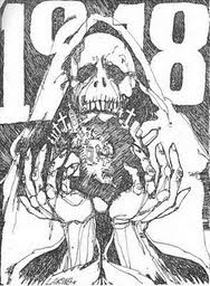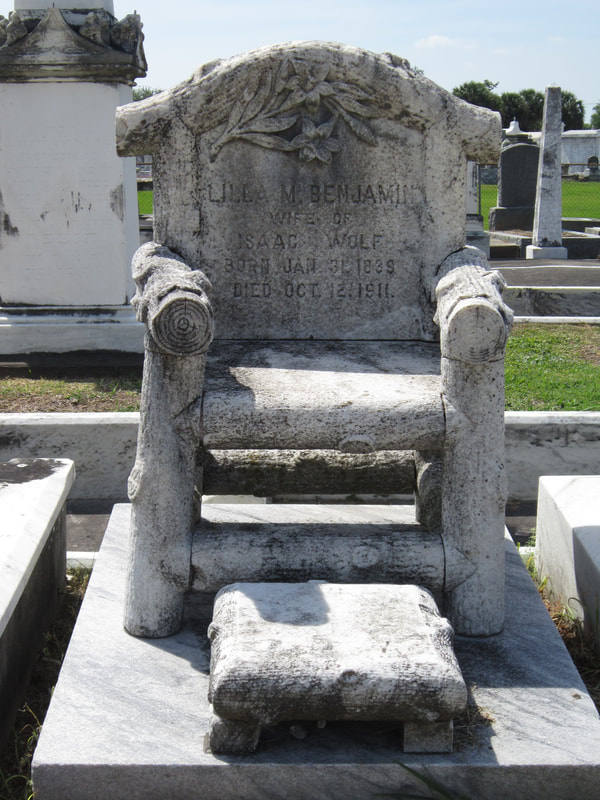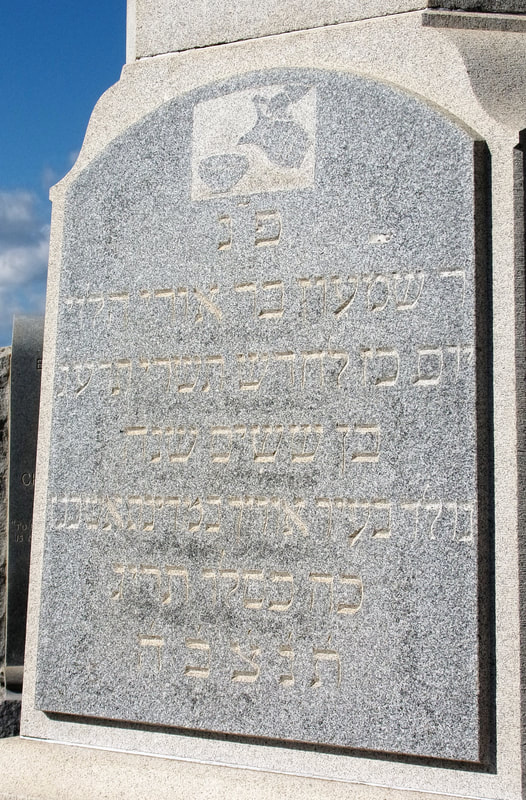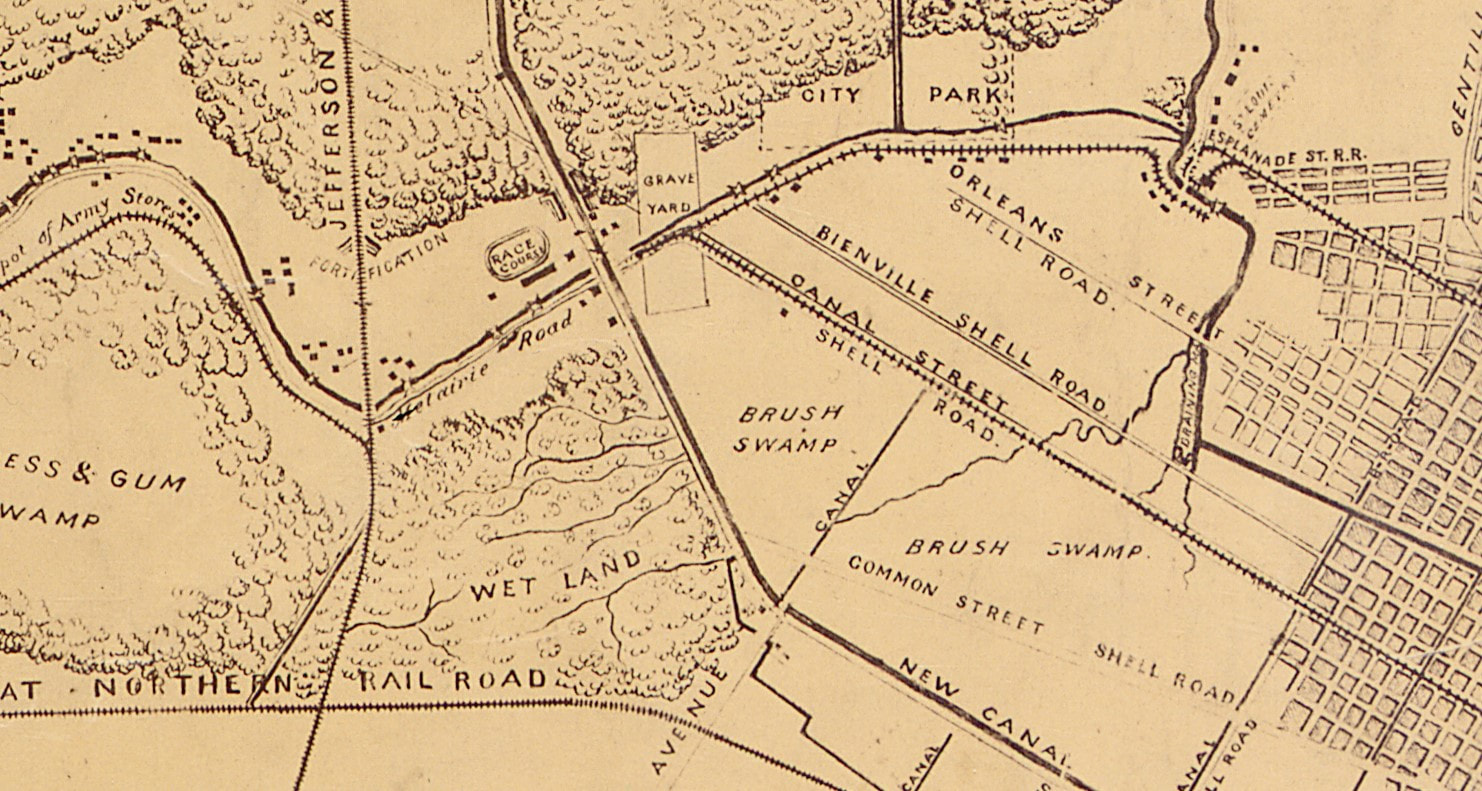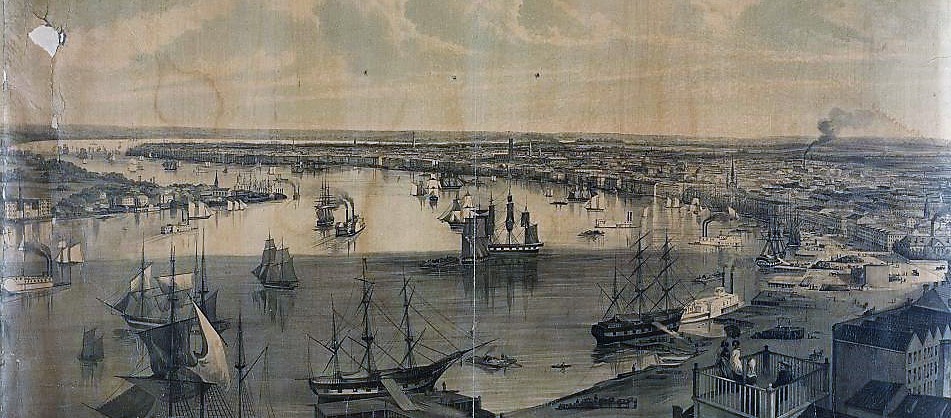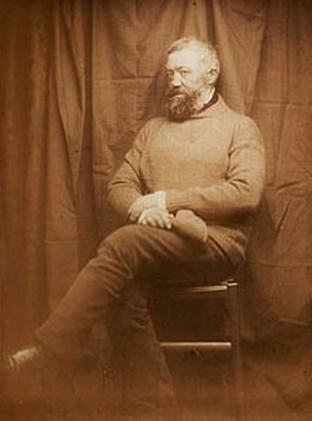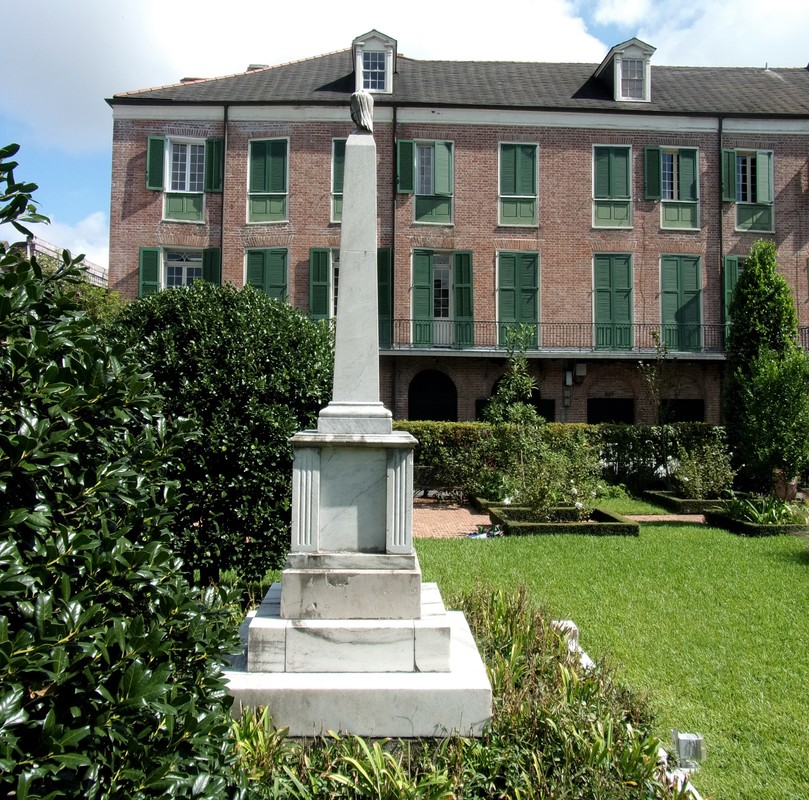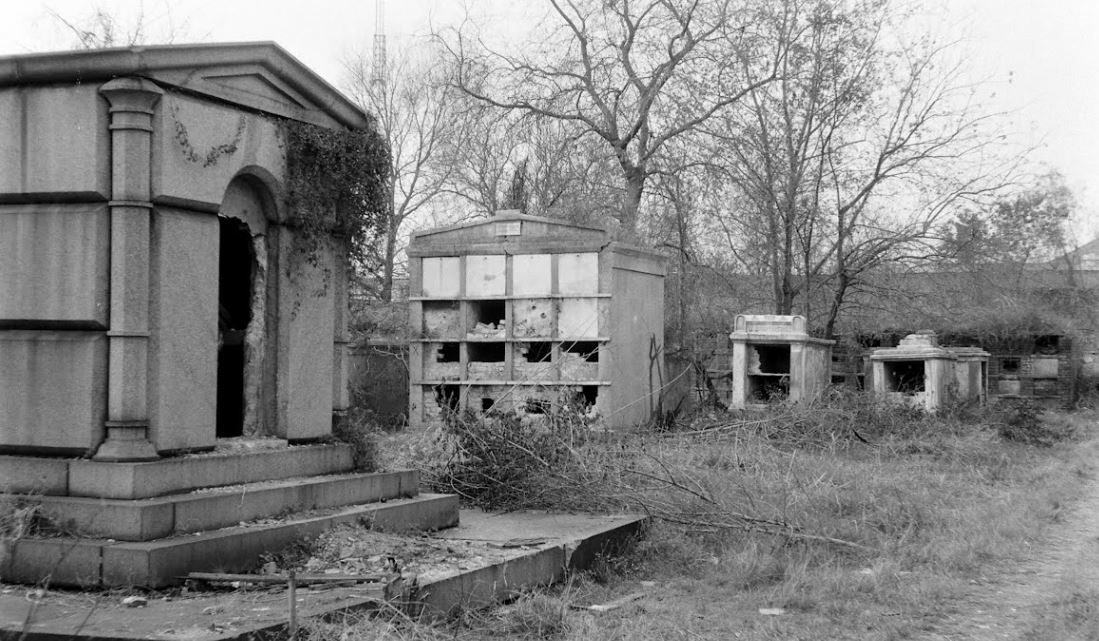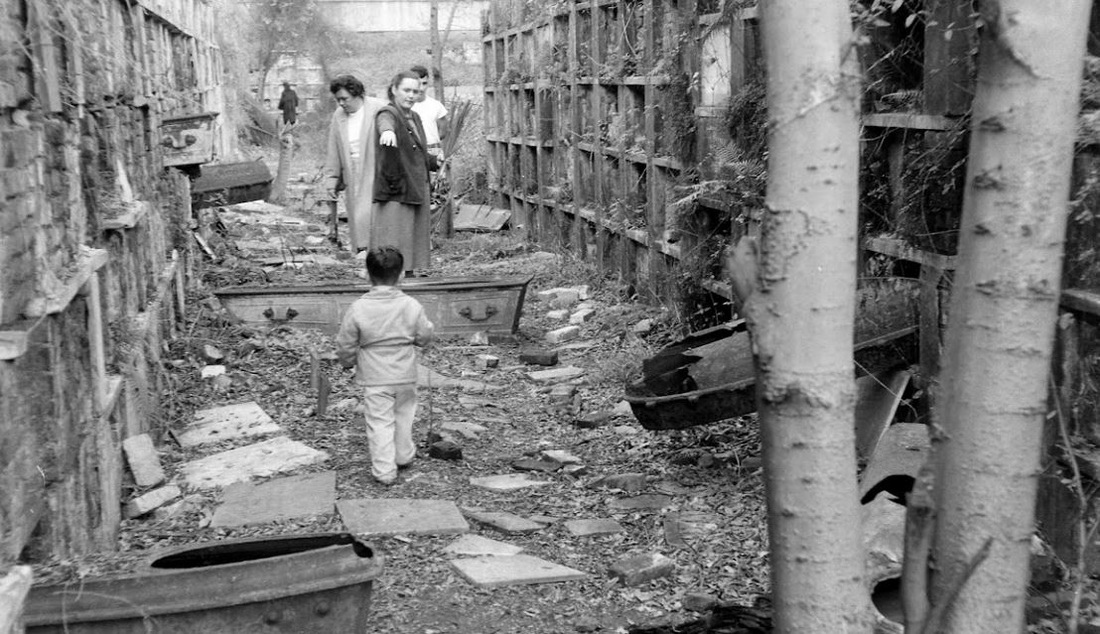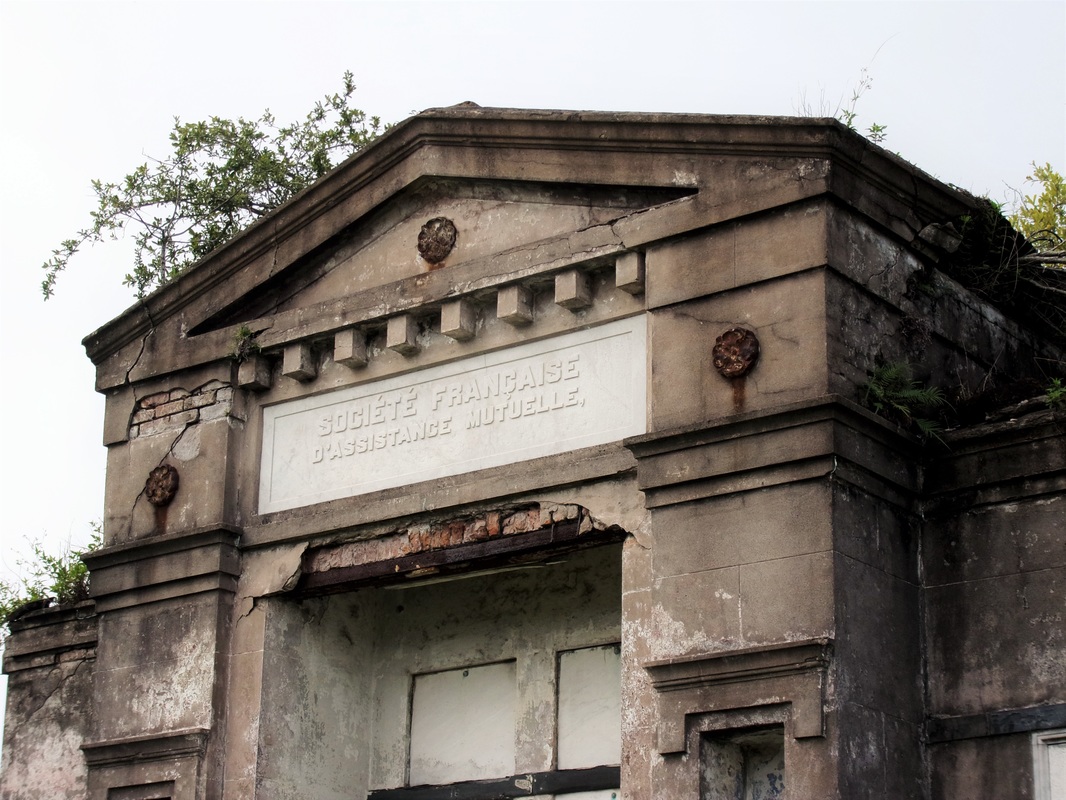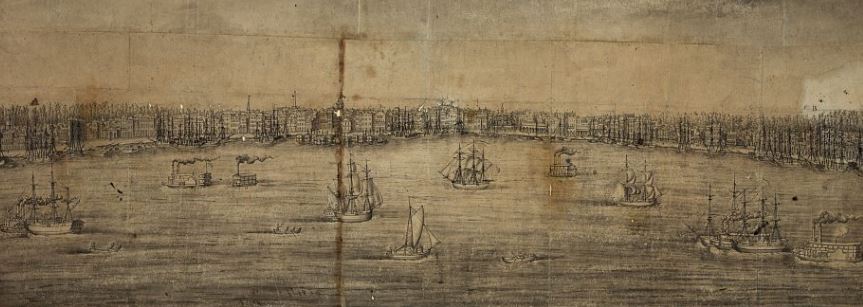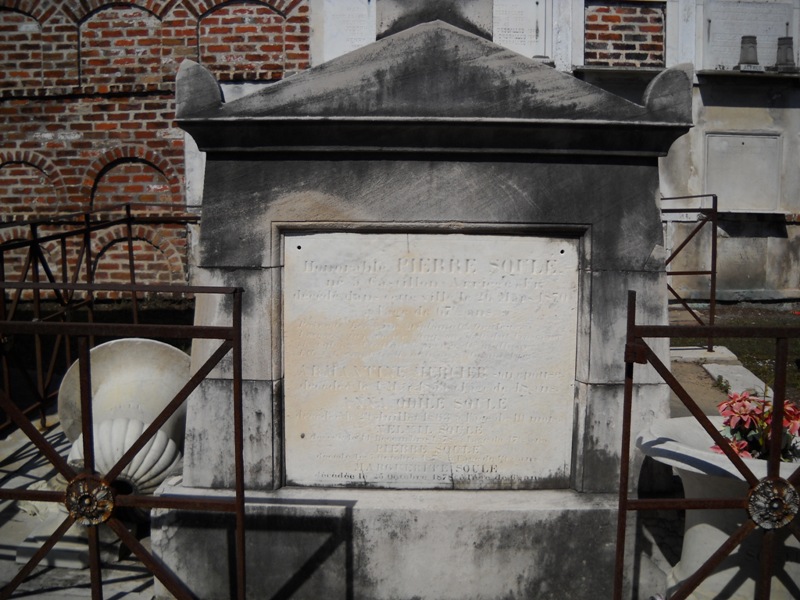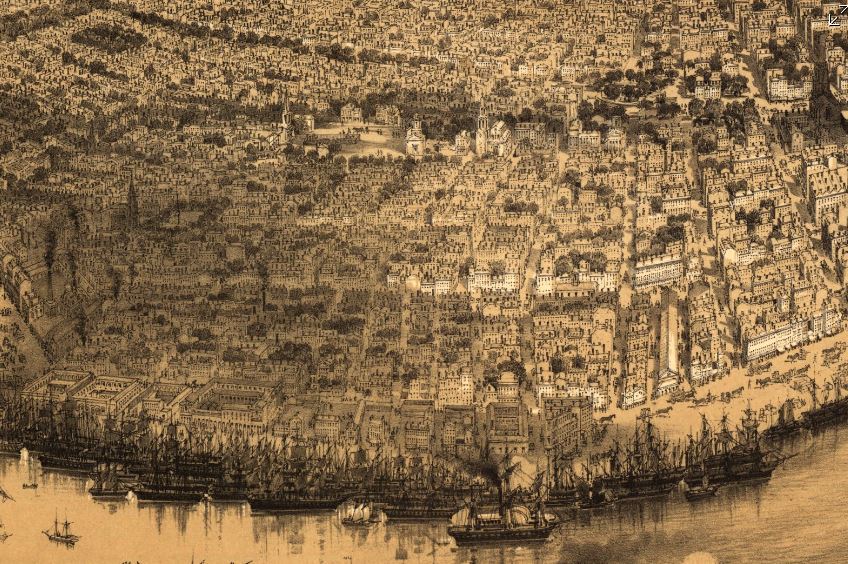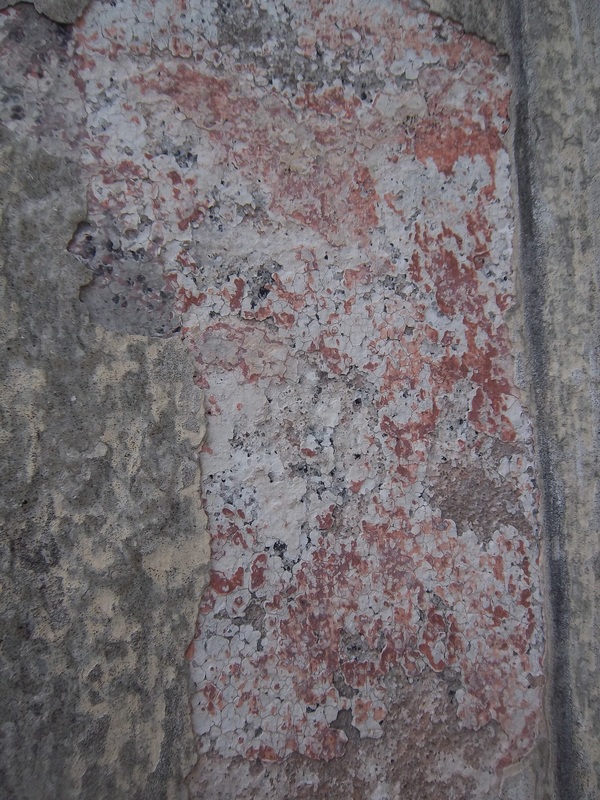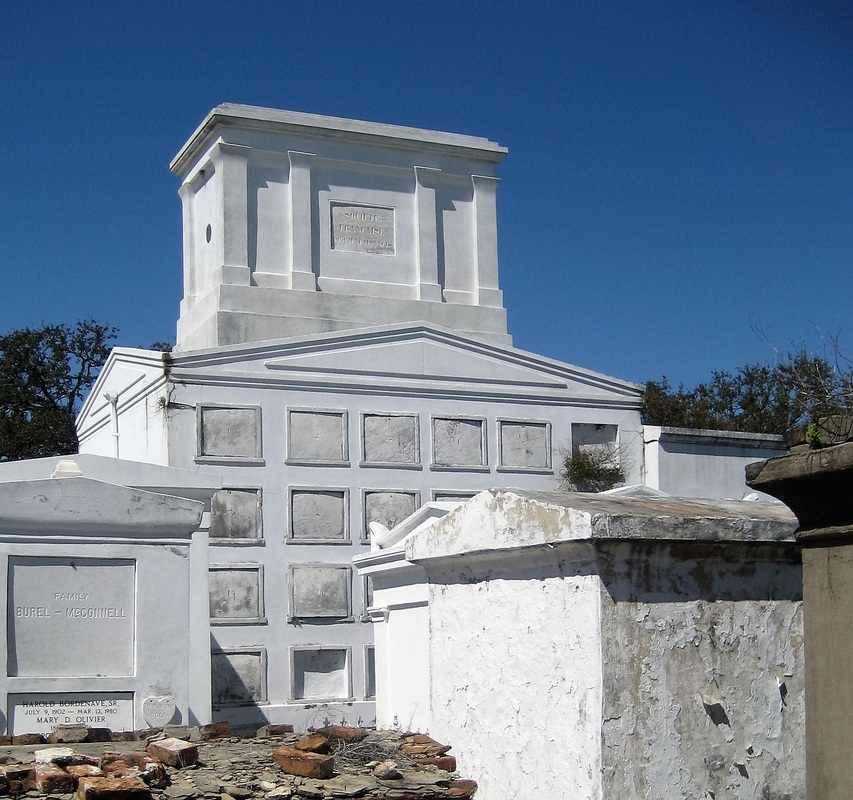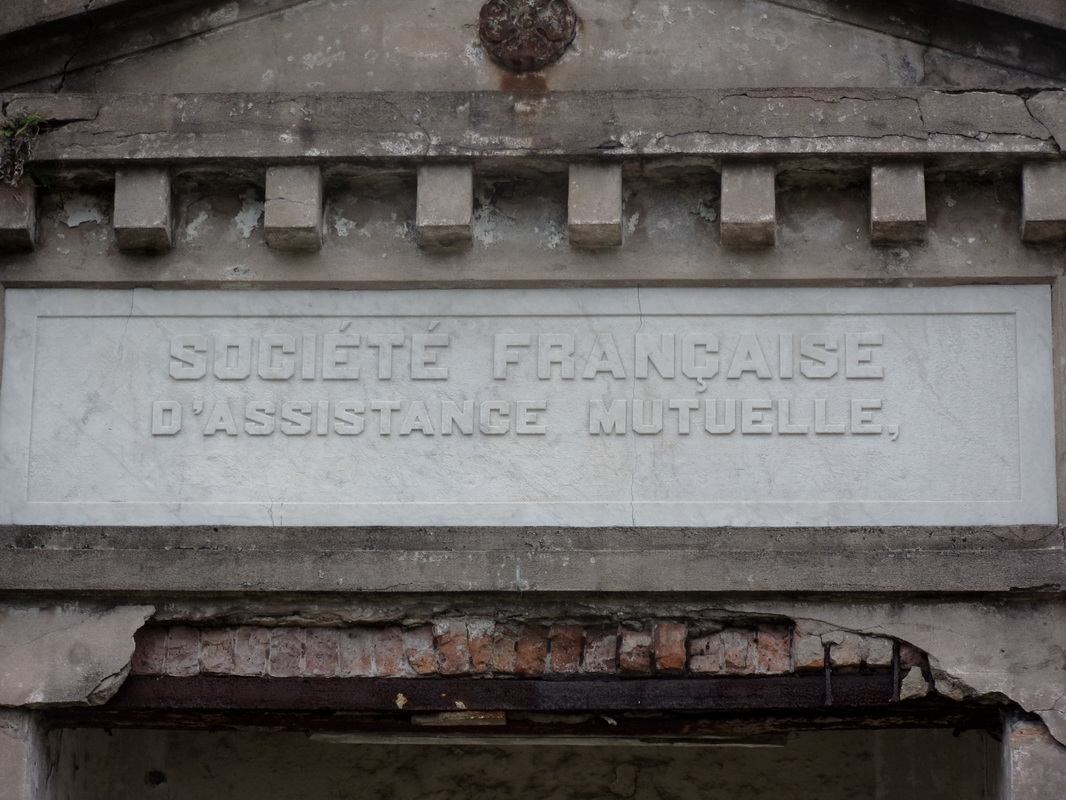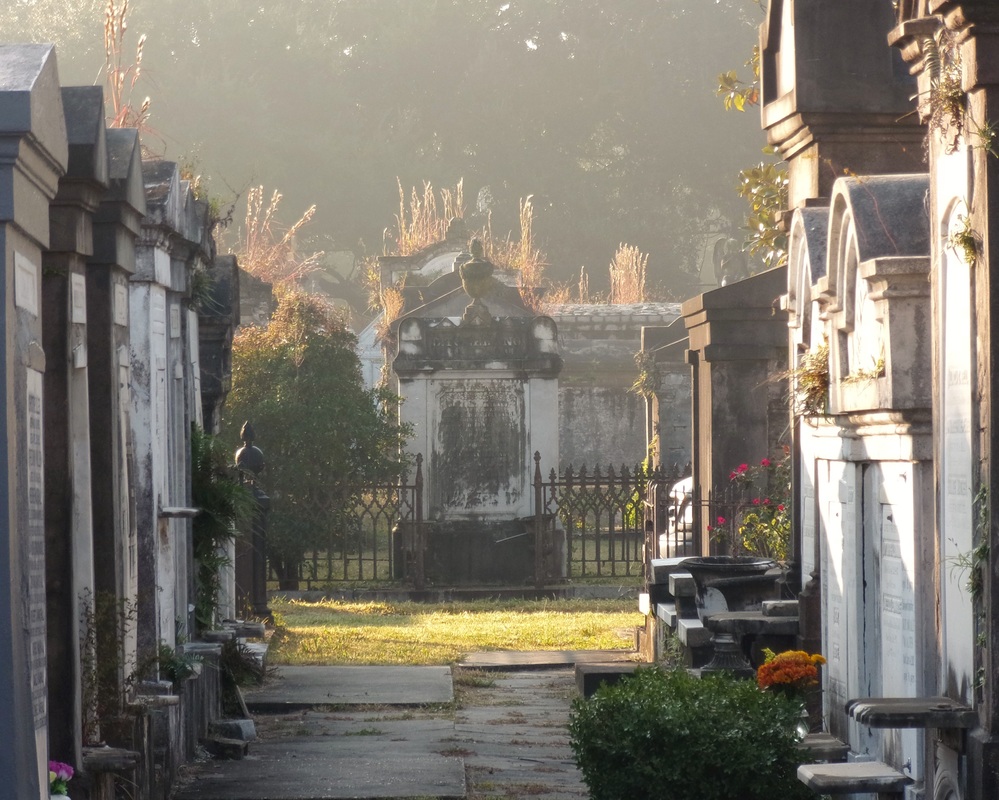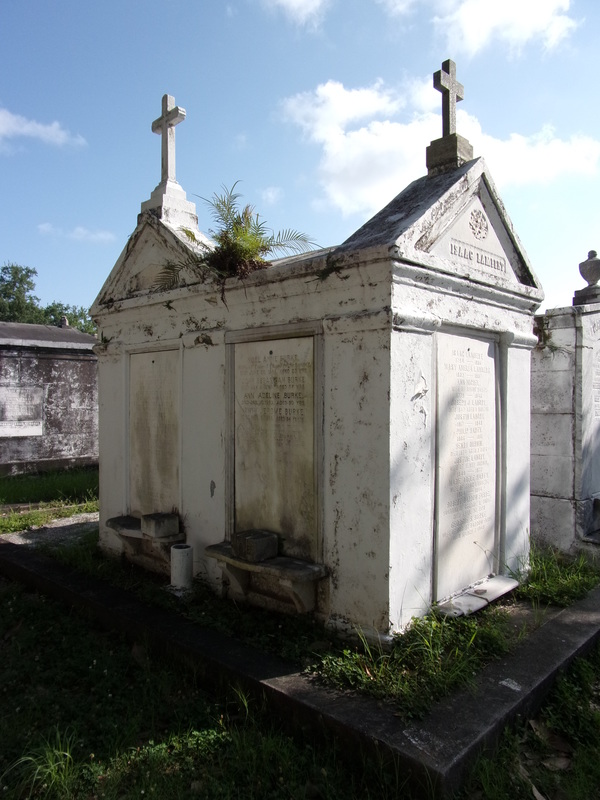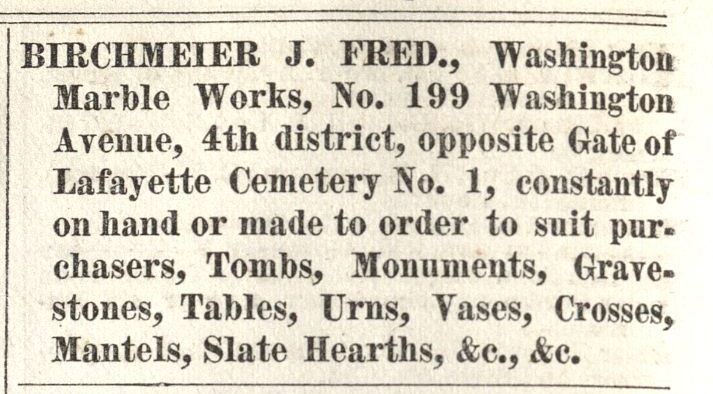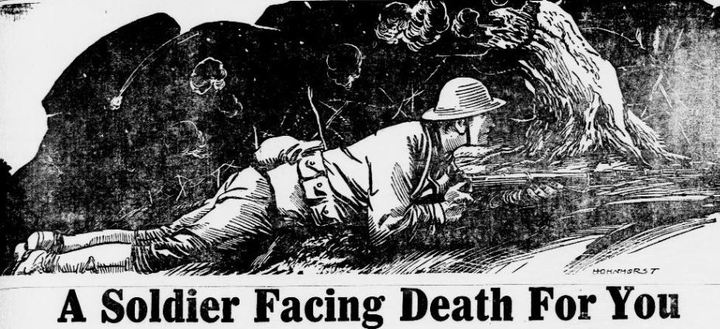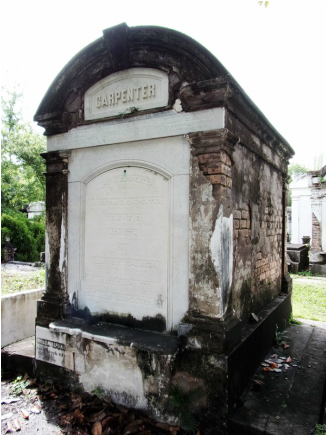|
How New Orleans weathered one of the greatest plagues in history. It’s nearly impossible to imagine a worldwide emergency like that which took place in 1918. Modern-day fiction and sci-fi writers have materialized similar fears – there is no shortage of post-pandemic fiction. For example, the HBO series The Leftovers posits a world in which two percent of the world’s population has vanished, the Max Brooks novel World War Z injects zombies into a frighteningly realistic image of how civilization would handle pandemic catastrophe. The list goes on. But we so often forget that something like this did happen. In 1918, a strain of pandemic influenza swept the globe three times, infecting millions and killing five percent of the world’s population. Medical science today cannot pin down exactly where it began. One prominent theory states that H1N1 influenza began with swine farms in Haskell County, Kansas in late January 1918.[1] Like other incidents of mutated influenza virus “jumping” from livestock to humans, it could have fizzled out in the local population. Yet nationwide mobilization in response to the United States’ entry into World War I meant that military camps were ubiquitous and population movement intensified. Influenza was transported to Camp Funston, Kansas, where it spread to other camps, other towns. The first wave of influenza traveled from the United States to Brest, France, in April 1918. Within the next month, it spread to Spain. Spain, neutral during World War I, was less likely to censor press reports of the disease. Hence, although the U.S., Britain, and France saw just as many cases of influenza, such incidents were not reported. The uneven press coverage created the appearance of the disease originating in Spain, giving it the incorrect moniker “Spanish Influenza.[2]” Influenza was documented in China and India by May 1918. The spring wave, however, was comparatively mild. The second wave of Fall 1918 would be devastating. As the summer of 1918 wore on and Allied victories in Europe continued, state and federal medical officials assumed disaster had been averted.
Attempts to quarantine the sick and curb the spread of influenza were often thwarted by the pressures of total war. In one especially salient instance, insistence from upper-crust social circles in Philadelphia caused medical leaders to allow a War Bonds parade to take place, despite the mounting evidence of an influenza epidemic. New cases of the illness soared in the days after this large public gathering. In metropolitan areas, the flu jumped from military to civilian populations, and then spread.
One hundred years ago this month, influenza arrived in New Orleans.
5 Comments
This is Part Two in a multi-part blog series examining the landscape history of what is now the intersection of Canal Street and City Park Avenue. From July to November 2017, construction will take place at this intersection to connect the Canal Streetcar to Canal Boulevard. Find Part One here. 1841: St. Patrick’s Cemetery At the same time that Americans from the northeast were moving en masse to New Orleans, a separate wave of immigration from Ireland made a great impact on the city. Immigrants fleeing famine and political unrest in Ireland came to New Orleans and settled mostly in what is now the Faubourg St. Mary neighborhood of New Orleans, abutting the Central Business District and what is now the Crescent City Connection bridge. These immigrants formed what is now Irish Channel, although the boundaries of this neighborhood have changed over time.[1] The neighborhood formed from settlement patterns dependent on the construction of the New Basin Canal. In 1833, the Parish of St. Patrick was founded to accommodate Irish Catholics in the neighborhood. By 1840, St. Patrick’s Church was constructed on Camp Street.
The St. Patrick Cemeteries, so fresh and clean in their snow-white garb and pebbly walks, always attract attention. Here lie the sturdy Irish pioneers who came to New Orleans in the early part of the last century and helped to make her history the proud tale it is… they breathe throughout the spirit of the Catholic faith. Special attention is directed to the beautiful Calvary shrine at the further end of St. Patrick’s No. 1 and the Mater Dolorosa that marks the entrance to St. Patrick’s No. 2.[3] The Calvary statue was designed by then-prominent monument man Charles A. Orleans, consisting of “a wooden cross twenty feet high with life-sized statues of the crucified Christ, Mary Mother of Jesus, His beloved disciple John, and Mary Magdelene. The statues were cast in Paris.”[4] In 1973, in the midst of trends toward community mausoleums, the Calvary was removed to make way for the Calvary Mausoleum. 1846: Dispersed of Judah Cemetery Along with Americans and Irish immigrants to New Orleans, another group of established immigrants and newcomers found their burial place at the end of Canal Street. Jewish people had long lived in New Orleans in small communities, first of primarily Sephardic Jews (of the Spanish-Portuguese tradition) from the Caribbean and England, then later Ashkenazi Jews from Germany and Alsace-Lorraine. These communities first organized in 1828 to found Gates of Mercy congregation, which had a synagogue on Rampart Street near St. Louis Cemetery No. 1. Gates of Mercy was an Ashkenazi congregation, and Sephardic Jews in New Orleans sought their own place of worship. This hope was fulfilled in 1846 when organizer Gershom Kursheedt helped aging benefactor Judah Touro found congregation Nefuzoth Yehudah (Dispersed of Judah) in 1846. Dispersed of Judah, a Sephardic congregation, was one of many religious organizations to benefit from Judah Touro’s generous will, which also founded Touro Infirmary, later to become Touro Hospital. In 1881, Dispersed of Judah and Gates of Mercy congregations would merge. The new congregation was eventually renamed Touro Synagogue. In the same year Dispersed of Judah congregation was founded, property adjoining St. Patrick Cemetery No. 2 along Canal Street was purchased for a cemetery. Dispersed of Judah was the second Jewish cemetery in New Orleans. Gates of Mercy had established a cemetery on Jackson Avenue near Saratoga Street in 1828, but this cemetery was demolished in 1957, part of a trend that will be discussed in a later part of this series. Thus, Dispersed of Judah Cemetery is the oldest surviving Jewish Cemetery in New Orleans. Members of Dispersed of Judah congregation were often tied to English colonial or business interests, arriving in New Orleans from the English-colonized Caribbean or New York. This Anglo-cultural tie, as well as a religious need to bury belowground, allowed Dispersed of Judah to grow into a small version of a northern cemetery. The landscape today retains some elements of this – box tombs and obelisks, trees, and raised monuments. The cemetery is probably best known for the marble monument of Lilla Benjamin Wolf (died 1911), carved into the shape of an empty chair with foot stool. A local story tells the sale of Mrs. Wolf sitting in her chair in life, outside her family’s shop, calling potential customers inside. This may have been a deeply personal choice of monument for the Wolf family, although “the empty chair” was also a common funerary symbol at the turn of the century. 1848: Charity Hospital Cemetery By 1848, Charity Hospital was an institution nearly as old as New Orleans itself. Founded in 1732, the hospital provided care to all patients without regard to race, nationality, religion, or sex. Throughout the nineteenth century, Charity Hospital cared for thousands of newly-arrived immigrants who fell ill after the trans-Atlantic journey, or who were especially susceptible to New Orleans epidemics of yellow fever and cholera.[5]  Charity Hospital's fifth building, in use from 1832 to 1939. Located on Common Street between St. Mary and Girod Streets, it was replaced in the 1930s by "Big Charity," a building designed by Weiss, Dreyfus, and Seiferth, who also designed the Louisiana State Capitol at Baton Rouge. Image from Harper's Weekly, September 3, 1859, via archive.org.
The firemen used axes to demolish the fence to save the [adjoining] St. Patrick’s Cemetery property, but nothing could be done to prevent destruction, and, after the flames had consumed the grass, covered the graves under smoldering ashes, with no crosses or headboards to identify the original plots, nothing was left for the friends or relatives of the dead to distinguish one grave from the other.[7]  Charity Hospital Cemetery in 2003, looking over the fence from St. Patrick Cemetery No. 2 and toward Canal Street. The flags present on the site suggest that it may have recently been mapped using ground-penetrating radar (GPR) to identify gravesites. Photo by Dale Boudreaux, via usgenwebarchive.com Charity Hospital Cemetery would receive scores of burials each day during successive yellow fever and cholera epidemics. Later, the cemetery would also receive the bodies of those who had donated their remains in death as medical school cadavers. After Hurricane Katrina, the cemetery would be revised into a new kind of memorial. 1849: Odd Fellows Rest Charity Hospital was the third cemetery to be established at the end of Canal Street. By that time, the land was still overwhelmingly rural, with few structures save the Halfway House and Toll House along the Shell Road, and the towering Egyptian pillars of Cypress Grove. But around the same time Charity Hospital Cemetery was established, another great landmark was in the works. The Independent Order of Odd Fellows (IOOF), a fraternal organization established in England in the 1700s, had founded a local lodge in New Orleans in 1833. The origins of IOOF’s name seem debated; one explanation has been that the “Odd” designation came from the society’s openness to all members despite trade or occupation. The official IOOF website tells a different story: “…it was odd to find people organized for the purpose of giving aid to those in need.” Indeed, the IOOF’s stated purpose is “Visit the sick, relieve the distressed, bury the dead and educate the orphan.” The Odd Fellows were also known as the “Three Link Fraternity,” a reference to their motto “Friendship, Love, and Truth,” often symbolized by the three-link chain. By 1858, the Grand Lodge of Louisiana had more than twenty subordinate local lodges, including the Crescent, Teutonia, Howard, Magnolia, Covenant, and Polar Star Lodges, all beneath the IOOF Grand Lodge umbrella. In addition to establishing widows’ and orphans’ assistance, and constructing one, and then another imposing Odd Fellows Hall building, the local Odd Fellows sought to establish their own cemetery by the late 1840s. Odd Fellows cemeteries were a national phenomenon in the nineteenth century, and can still be found in places as disparate as New Jersey, Texas, Nebraska, California, and Oregon. New Orleans Odd Fellows sought to do the same. Previous to this time, the land acquired by respective cemetery owners like St. Patrick’s Church, Charity Hospital, and the Firemen had been allotted using lines of property demarcation corresponded to Lake Pontchartrain and not the Mississippi River, leading to the long lots exemplified best by St. Patrick Cemetery No. 1, 2, and 3. These property lines ran across Bayou Metairie at angles, leaving a small triangle of land wedged between St. Patrick Cemetery No. 2, Bayou Metairie, and Canal Street. In 1848, the Grand Lodge of Louisiana IOOF purchased this small triangle of land for use as their cemetery – the first, but not the last fraternal cemetery at the end of Canal Street.[8] On February 26, 1849, the various Odd Fellows Lodges converged on the Place d’Armes (Jackson Square) to form an “exceedingly beautiful” procession to celebrate the consecration of Odd Fellows Rest.[1] The parade of hundreds was decked in black crape, banners, and emblems of the many symbols recognized by the Odd Fellows. They marched through the French Quarter in a serpentine route, up one street and down another, across Canal Street and through the American Sector (now the Central Business District) where they converged at the New Basin Canal and boarded carriages to proceed up the New Shell Road to the Halfway House.[2] At the Halfway House, the Odd Fellows re-formed their procession, following a carriage drawn by six gray horses and carrying a sarcophagus containing the remains of sixteen Odd Fellows, exhumed from other cemeteries to be re-interred at Odd Fellows Rest. The procession entered through the cemetery’s gate, a granite Egyptian Revival post-and-lintel that mirrored in style if not size the grand entrance of Cypress Grove immediately across Canal Street. Once inside, the parade ended at the center of the cemetery, where a tomb had been prepared. Poems were read and oratories recited, and the remains reburied. The entrance to Odd Fellows Rest would remain at the center of its Canal Street boundary for more than fifty years. The granite entryway was enclosed by two cast-iron gates produced in Spain for the Odd Fellows that portrayed dozens of the Order’s symbols: cornucopia, beehives, globes, books, shepherd’s staffs, stars, axes, and a mother protecting four children. The gates were surmounted by finals depicting the sun and moon, and atop all of this was the perennial Odd Fellows Symbol, the heart-in-hand. In the mid-twentieth century, New Orleans photographer Clarence John Laughlin would capture the gates in their historic context, complete with detail and careful multichromatic paints. By the 1970s, much of the original ironwork had been stolen or lost. Within the walls of Odd Fellows Rest, the cemetery would be populated by hundreds of enclosed wall vaults, belowground burials, high-style tombs, and even a tumulus. In the 1850s, local sculptor and stonecutter Anthony Barret (1803 – 1873) constructed a 48-vault society tomb for the Teutonia Lodge of the Grand Order IOOF. The society tomb, later transferred to Southwestern Lodge No. 42, was designed reminiscent of an Italian loggia, with each arched group of vaults framed by inverted torches carved in marble. The Teutonia Lodge tomb was surmounted by marble urns on each corner of its roof. At the primary façade of the tomb was the piece-de-resistance of the structure: a remarkably ornate marble panel carved with dozens of symbols of the Order, each framed with fine scrollwork carved in relief. At the center of the panel, the protecting mother sits nursing a baby and wrapping her cloak around another child. Anthony Barret was well known for his remarkable stonework, carving some of the finest relief sculptures found in the Lafayette Cemeteries and elsewhere. Even still, the Teutonia Lodge tomb is the greatest artistic accomplishment of Barret’s to survive into the present day. [1] Campanella, Bienville’s Dilemma, 172.
[2] Dell Upton, “The Urban Cemetery and the Urban Community: The Origin of the New Orleans Cemetery,” in Exploring Everyday Landscapes: Perspectives in Vernacular Architecture, ed. Annmarie Adams and Sally McMurry (Knoxville: The University of Tennessee Press, 1997), 132-133, 139-140. [3] The New Orleans Picayune, The Picayune’s Guide to New Orleans (New Orleans: The Picayune, 1904), 152. [4] Leonard Victor Huber, Peggy McDowell, Mary Louise Christovich, New Orleans Architecture, Vol. III: The Cemeteries (Gretna: Pelican Publishing, 2004), 33. [5] John E. Salvaggio, New Orleans’ Charity Hospital: A Story of Physicians, Politics, and Poverty (Baton Rouge: LSU Press, 1992), 35-45. [6] “Second Municipality Council,” Daily Picayune, May 19, 1847, 2. [7] “A Cemetery Blaze: Flames Sweep the Spot where Charity Hospital Dead are Interred,” Times-Picayune, February 27, 1905, 11. [8] An 1833 map of New Orleans from the Mississippi River to Lake Pontchartrain shows the intersection of Bayou Metairie and the New Basin Canal divided into properties belonging to the New Orleans Banking and Canal Company, and illustrates how the property lines correspond with Lake-oriented parcels. A high-resolution of that map is available here. [9] “Consecration of Odd Fellows Rest,” Daily Crescent, February 27, 1849, 1. [10] Ibid. New Orleans is home to dozens of cemeteries, each with its own character and history. Among these many burial and interment grounds are the influences of world cultures, human expressions of grief, and iterations of architecture that, in one way or another, are recognized as significant on small and large scales. Some are more appreciated than others. Some have been lost entirely from the landscape, such as St. Peter Street Cemetery, Girod Street Cemetery, or Gates of Prayer Cemetery on Jackson Avenue. Yet among these recognized and unrecognized burial grounds, there is one nearly always omitted, even though people walk by it and photograph it every day. Tucked behind St. Louis Cathedral and often overshadowed by the looming statue of the Sacred Heart of Jesus, is the final resting place of nineteen French navy men who died in 1857 and were re-interred at this place in 1914.
In the years following this harrowing incident, the surviving crew of the Tonnerre and their families in France, as well as French naval authorities, sought to memorialize the lost sailors. A monument was erected in the Quarantine Station cemetery in August 1859. The marble obelisk would not be seen for long, however. The Quarantine Station was soon relocated, with the former site abandoned. The monument would not be rediscovered until 1914, when Andre Lafargue endeavored to reclaim it.[3] The tale of the Tonnerre, its crew, and its monument, highlights so many historical aspects of the mid-nineteenth Caribbean and Atlantic world. It is a story of memorialization and reclamation, of the interactions between cultures and nations, and of the management of public health in this time. In this post, we seek to unpack some of these curious aspects of the monument that rises so subtly from behind St. Louis Cathedral. The Ship Tonnerre The Tonnerre is referred to in historical documents as both a corvette and an aviso or “advice ship.” While there appears to be some distinction between the two (and we don’t presume to call ourselves naval historians) – for example, avisos are customarily smaller than corvettes – documents consistently refer to the Tonnerre as a ship assigned the duty of relaying messages between larger naval commands. The four-gun Tonnerre was a steam-powered vessel, propelled by a paddle, and was inducted into service by the French Navy at Indret in 1838.[4] By 1850, the French Navy had about a dozen such first class “advice boats,” including five constructed of iron (Le Mouette, Le Heron, Le Eclaireur, Le Requin, and L’Epervier), although the Tonnerre was not constructed of iron. By 1857, the Tonnerre and its crew had already completed service in the Crimean War (1853-1856) in which an alliance of European powers fought Russia for influence over the Black Sea and Middle Eastern. Lieutenant Clement Maudet, who came to command the Tonnerre, fought with the French Foreign Legion in Crimea, earning a medal for his bravery. Many of the other sailors aboard the Tonnerre served in this conflict before being dispatched to the Caribbean. The presence of the Tonnerre in the Caribbean also highlights the colonial and military interactions in the Caribbean and Atlantic world at the time. The Tonnerre was charged with relaying messages between Vera Cruz and Havana (a role the ship would serve through the late 1850s).[5] The ship’s mission likely related to French economic and political interests in Mexico, which Emperor Napoleon III viewed as critical to Latin American trade access. French intervention would escalate to full on invasion in 1861, and later the unsuccessful installation of Hapsburg emperor Maximilian I. It was in this conflict in 1863, that Lieutenant Clement Maudet would die of wounds acquired in the Battle of Camerone.[6] The Tonnerre was the fifth ship of the French navy to bear this name. The first French Naval Tonnerre was the British HMS Thunder, captured in 1696. The Tonnerre under Maudet’s command in 1857 was retired in 1878. The French Navy currently operates the eighth Tonnerre, placed into active service in 2006. The Crew The Tonnerre had an original crew of eighty sailors, including a doctor (who died of yellow fever at the Quarantine Station), sailors, ensigns, stokers (steam engine operators), chefs, and mates. Eighty of whom contracted yellow fever either in Mexico, Louisiana, or Cuba. Thirty of these seamen died. Two of the chefs aboard the Tonnerre who perished in 1857 appear to have been of Italian descent: Giovanni Carletto and Jean Janotti. Ages of the men who died aboard the Tonnerre are not listed.
In 1853, for example, the fever was presumed to be caused by “miasmas” or “bad air” (a theory derived from Enlightenment thought), and thus the City burned torches of pitch and discharged cannons in order to disperse airborne maladies. By the 1850s, the Sanitarian movement had begun to marginally influence public health, focusing on cleanliness of public spaces and the removal of fetid water. Quarantine Stations were present in most eastern seaboard cities by the early 1800s. In New Orleans, the necessity of such stations was frequently debated and they were often decommissioned. In many cases, New Orleans merchants were staunch opponents of quarantine. Such systems, they said, disrupted commerce and were thus unacceptable. Their arguments appeared validated when, on occasion, epidemics broke out despite the presence of quarantine stations – likely due to the yellow fever mosquito (Aedes aegypti)’s fondness for sheltering in ship cargo holds. Incidentally, however, 1857 was not a significant epidemic year for New Orleans. As the Tonnerre had no intention of docking in the City en route to Havana, the condition of this one ship’s crew posed little danger of epidemic to the Crescent City.
The Quarantine Station would be abandoned after the 1860s, after the US Government established an additional Quarantine Station at Ship Island, Mississippi. In 1880, the Louisiana Board of Health reported on the condition of the Ostrica-area Station, the grounds “open and roamed over by cattle.[10]” It described a complex of several buildings: a fever hospital, a pox hospital, a medical residence, a boatmen’s quarters, and a warehouse. Said the board of the process of disinfection at the hospitals: The process of disinfection now employed consists of burning sulphur in iron pots. These pots are placed in tubs containing water. This method is liable to the grave objection that there is, in many cases, and especially during rough weather, danger of firing the ship.[11] In this report, the Board of Health appears to be investigating the feasibility of placing the Station back into service, although no evidence suggests this happened. However, the report documented the enduring presence of the Tonnerre monument: The graveyard of the Quarantine Station is located about 200 feet to the rear of the Fever Hospital, and is surrounded by a rude fence and covers about three-fourths of an acre. Marks of about one-hundred graves can be discerned by the inclosure [sic], which are thickly covered with tall grass, brambles, and shrubs. There is only a solitary marble monument, which bears the following inscription: "A la mémoire de Trente Marins, faisant partie de l'équipage de l'avito vaisseau de la Marine Imperiale le Tonnerre, décède à la Quarantaine de la Nouvelle Orléans en Août, 1857. Erige par l'Odre de S.E. L'amiral Hamelin, ministre de la Marine de l'Empereur Napoléon III.”[12] The Monument Thanks to donations from the families of surviving Tonnerre crewmen, a marble monument was installed at the Quarantine Station in 1859. Unfortunately, the craftsperson that designed and built it is unknown. Photos from the monument’s recovery indicate that it was originally a marble-clad box tomb, with fluted corner pieces and a marble slab atop which the monument’s obelisk and urn were fixed. This style of memorial was typical of 1850s high-style cemetery architecture in both New Orleans and France. Derived from sarcophagus designs, similar monuments can be found in the cemeteries of Montparnasse (France) and St. Louis Cemetery No. 2, although less modified versions are visible in the upriver parishes. The Tonnerre monument was described intact by the Louisiana Board of Health in 1880, even though the Quarantine Station cemetery had become derelict. Andre Lafargue shares a similar recollection from his youth, seeing the monument ascending from the brush as he traveled the river. Lafargue notes that at some time between 1880 and 1914 the obelisk fell in a hurricane.[13] The Quarantine Station long abandoned, without intervention the Tonnerre monument would have sunken beneath overgrowth and debris. Yet in 1914, Andre Lafargue, who at that time served as the attorney for the Comité du Souvenir Francais, came across in the French Society records documentation of the Tonnerre monument. In an effort that proved fruitful if not also tremendous and risky, Lafargue chartered a boat from Buras to Ostrica, bringing with him the vice French consul general at the time, Andre Lacaze, and their wives.[14] Trudging through the brush with only a vague recollection of where the cemetery and Quarantine Station once stood, the party discovered the remains of the monument: We finally came to a spot, near a tree of greater dimensions than the others, and there found traces of former habitations, and all of a sudden our feet struck a pile of bricks and pieces of marble and we knew, after examination of the fragments, that we had finally found the spot where the cemetery stood long years before and where the monument had been built. The ladies, highly elated by the discovery, were very helpful in picking up various pieces of the pedestal and we finally located the obelisk, the main section of the most important part of the monument, and the gracefully draped urn. The urn had been wrenched from the top of the obelisk and the latter had broken into two pieces in its fall to the ground, after the pedestal and the foundation had been undermined by the elements and the rough usage of time.[15] Over the course of subsequent trips to the site and through partnerships with groups like the Societe de Bienfaisance et d’Assistance Mutuelle, the monument was packed away and sent upriver to New Orleans. Despite the contestations of local undertakers that recovery of the remains of the 19 seamen who died at the Quarantine Station would be impossible, Lafargue and his crew set out to disinter each one. Each body was laid beneath the flag of France during disinterment, then shrouded and placed together in a metallic casket, where a single French flag was draped across them. In an additional gesture of reverence, the party uprooted a small tree from the cemetery and placed it in the coffin with the remains, to be re-planted at the new monument site.[16] The monument was reconstructed by New Orleans stonecutter and tomb builder Albert Weiblen. Weiblen built a burial vault atop which the monument would sit and bordered with a Georgia Creole marble coping wall. This vault forms a tumulus structure and simultaneously elevates the monument. Weiblen’s skill in reconstructing the monument is remarkably evident: it is difficult to determine which elements of the monument are replacements and which are original. But some clues are visible: one inscribed tablet is of a slightly different type of marble, and is inscribed with a pneumatic tool, whereas the other inscribed faces of the pedestal have smaller, hand-carved lettering. It appears as if the monument itself may have been slightly downsized, it’s dimensions shaved away to remove damaged or unsalvageable elements. A small bronze plaque was installed at the front of the coping by De Lucas Monument Company at the cost of $13.[17] Since its rededication, the Tonnerre monument has survived a few more hurricanes, and an instance in the 1930s in which an inebriated driver crashed through the gates of the Cathedral garden and toppled the obelisk. But for the most part the monument (and the remains therein) have known peaceful repose, quietly situated between St. Louis Cathedral and Royal Street, so often escaping notice. [1] Andre Lafargue, “The Little Obelisk in the Cathedral Square in New Orleans,” Louisiana Historical Quarterly, Vol. 28, No. 1 (Jan. 1945), 329.
[2] Every history of the Tonnerre’s trials at the Louisiana quarantine station omits the commander’s first name. Based on other histories of the French Navy in the Baltic and Mexico, and other statistical data, the commander of the Tonnerre was most likely Clement Maudet (1829-1863), French Legionnaire, who would die later in Mexico during the Battle of Camarone, part of the Second French Intervention. [3] Ibid., 333-336. [4] John Fincham, A History of Naval Architecture, to which is prefixed an introductory dissertation on the application of mathematical science to the art of naval construction (London: Whittaker and Co., 1851), 408. [5] French war steamer Tonnerre embarks from Havana to Mexico, Daily Picayune, October 21, 1857; French war steamer Tonnerre returns to Havana, Daily Picayune, December 14, 1857. [6] This is an extremely generalized recapitulation of colonialism in the Caribbean in the 1850s. For further reading see: The Second French Intervention in Mexico, The French Intervention in Mexico and the American Civil War, and if all of this is too complicated or frustrating, just check out this fun comic. [7] Henry Rightor, Standard History of New Orleans, Louisiana (New Orleans: Lewis Publishing Company, 1900), 211-213. [8] John Duffy, The Sanitarians: A History of American Public Health (Chicago: University of Illinois Press, 1992), 60; Joy J. Jackson, Where the River Runs Deep: The Story of a Mississippi River Pilot (Baton Rouge: LSU Press, 1993), 55; Alcee Fortier, Louisiana: Comprising Sketches of Parishes, Towns, Events, Institutions, and Persons, Arranged in Cyclopedic Form, Vol. 2 (Century Historical Association, 1914), 337. Jackson notes quarantine stations located at Cubit’s Gap (around 1910) and a post-1920 station at the lower end of Algiers. Andre Lafargue describes a quarantine station at Pilot Town, twenty miles downriver from Ostrica, by 1914. [9] John Duffy, ed. The Rudolph Matas History of Medicine in Louisiana, Vol. II (Binghamton, New York: Vail-Ballou Press, Inc., 1962), 185-186. [10] Joseph Jones, M.D. Report of the President of the Board of Health of the State of Louisiana for the Year 1880, 14. The report also notes the success of quarantine measures for that year, including the removal of the bark Excelsior, bound from Rio de Janiero, to Quarantine, which “certainly freed the city of New Orleans from the infected crew, and in the opinion of a portion of at least of the medical profession, preserved the citizens from an epidemic.” [11] Ibid., 18. [12] Ibid., 15. [13] Andre Lafargue, “The Little Obelisk in the Cathedral Square in New Orleans,” 336. [14] John Smith Kendall, A.M., History of New Orleans, Vol. III (Chicago: Lewis Publishing Company, 1922), 1149. [15] Ibid., 338. [16] Ibid., 336-342. There is no indication that this tree remains in the garden behind St. Louis Cathedral. [17] Receipt from De Lucas Monument company to Comite Francaise, Andre Lafargue papers, MSS 552, Folder 10, Tulane Louisiana Research Collection. This blog post was inspired by the photos within, most of which were taken by Robert W. Kelley of LIFE Magazine in 1957. These images show Girod Street Cemetery in its final moments, as well-dressed adults and children mill around its collapsed tombs and open vaults, with newly-built New Orleans City Hall present in the background of many shots. Mis-labeled “Gerard” Street Cemetery, they offer a vignette of what has long since disappeared from the New Orleans landscape. The full album can be found via Google Cultural Commons here. The topic of Girod Street Cemetery is one that comes up in a few varieties of conversation among New Orleaneans, most often related to the charming notion that the Louisiana Superdome was built atop the burial ground (it wasn’t, per se). The relationship of the old cemetery, known also as the Protestant Cemetery, to the New Orleans Saints football team is one that has been described many times over, best by Richard Campanella and Doc Boudin of Canal Street Chronicles. Check them out to see why you can’t blame the vengeful dead for a losing season. The Protestant Cemetery, 1822 – 1940 The former footprint of the cemetery, however, was indeed quite close to the present-day Superdome. Originally bounded by Liberty, and the former Cypress and Perillat Streets, the cemetery once stood beneath where Superdome parking garages and the Champions Square complex now rise. Founded in 1822, this once-distinctive cemetery lay at the terminus of Girod Street. Previous to that date, non-Catholics were buried in the rear of St. Louis Cemetery No. 1. The narrow “Protestants Section” in St. Louis No. 1 was once much longer, but was truncated after construction to Treme Street in 1820. Shortly afterward, Episcopal Christ Church was awarded the land that became Girod Street Cemetery. Over the course of the nineteenth century, Girod Street Cemetery developed into a landscape distinct from its New Orleans cemetery sisters. As the second-oldest cemetery in the city, it amassed the vestiges of early cemetery architecture, from single-vault, stepped-roof structures to more ambitious marble-clad and Classically inspired sarcophagus tombs. The tomb of Angelica Monsanto Dow, who died in 1821, reflected this aesthetic well. Girod Street Cemetery furthermore was an “American” cemetery, in that it became the final resting place for many New Orleans residents who had travelled from elsewhere, particularly the Anglo-American north and Midwest. From these outsiders came tombs and materials inspired by northern cemetery designs – clean, wire-cut Philadelphia brick, liberal use of stone urns and many, many obelisks. Girod Street Cemetery kept within its walls a tableau of cemetery artisanship that stood out from the landscapes of its sister Catholic, municipal, and fraternal cemeteries. Through the nineteenth and into the twentieth century, Girod Street Cemetery would become the final resting place for many New Orleaneans of distinction. Heroes of the Mexican American War, civic leaders, and prominent families utilized the burial ground. One estimate suggested that the cemetery was once home to 100 society tombs. For comparison, Lafayette Cemetery No. 2, which is usually noted for its society tombs, has just twenty. In Girod Street Cemetery, the tomb of the New Lusitanos Benevolent Society was likely the most notable. Designed by J.N.B. de Pouilly and erected in 1869, the tomb had 100 vaults and a walk-in vestibule framed with a Classical portico. Being somewhat centrally located, Girod Street Cemetery was also heavily utilized as a public burying ground in times of epidemic. It seems as though nearly every major epidemic of the nineteenth century involved a terrible debacle at Girod Street Cemetery, in which bodies were stacked beyond capacity with no one to bury them. This may have also been due to the presence of a de facto Potter’s Field adjoining the cemetery, which was described as early as 1837: “This latter receptacle of the dead [the Protestant cemetery] has for many years been a disgrace to New Orleans. Once the Potters’ Field, it soon became the public burying ground, provided you were able to pay for a vault – otherwise you had to be sent further out into the swamp.”[1] The 1833 cholera epidemic in New Orleans proved especially tragic for Girod Street Cemetery, although it was not necessarily the last time the cemetery fell prey to insufficient manpower in the face of great loss of life: … the unshrouded dead dumped at the gateway of the Girod Street Cemetery accumulated in such numbers that the entrance to its precincts was so obstructed that arriving bodies had to be deposited on the outside; no graves at this time could be dug; no coffins were procurable, for there were neither grave diggers to be had nor undertakers to be found. The City Council was forced to order out the chain gang ‘prisoners’ from the city jails, to dig a trench the whole length of the lower side of the cemetery. It was dug some twelve or fifteen feet wide, and as deep as the filtering water soil would permit, into this receptacle the decomposing bodies were dragged by hooks from the fire companies, without the formality of precedence or order of any kind. As a part of the trench was filled, the earth taken from it was heaped upon the remains of the rich and the poor, the aged and the young.[2] This mass grave would eventually be erroneously referred to as the “yellow fever mound” in later years. In the late 1940s, historians would determine that this feature was in fact the burial of 1833 cholera victims.[3] The Back of the Swamp Girod Street Cemetery, for its stately obelisks and high society residents, would be plagued with issues surrounding its management and topography for most of its existence. In the 1830s, only years into its functional life as a cemetery, it would be noted that its vaults were built with only one brick thickness to their walls, which permitted the “escape of unhealthy odors.”[4] However this was not an issue exclusive to Girod Street – City ordinance did not regulate the quality of tomb construction until the 1850s. What did afflict Girod Street perhaps more than other cemeteries was its location in significantly low-lying land. Girod Street Cemetery swelled with feet of water in Sauve’s Cravasse of 1849, and frequently took on water in other instances, owing to its place on swampy land. In 1880, a special commission of Louisiana state representatives assessed the condition of New Orleans cemeteries and found them all to be in “proper” condition – with the exception of Girod Street Cemetery. Noting, “in the event of rain [Girod Street Cemetery] is always flooded to such an extent that it will affect the sanitary precautions necessary to prevent the contracting or spreading of any diseases,” the commission recommended the cemetery be closed. This recommendation was apparently declined.[5] Girod Street Cemetery’s troubles would not end there. The Fall of Girod Street Cemetery Through the course of its existence, Girod Street Cemetery was owned and operated by Christ Church Cathedral. Until the mid-twentieth century, most religiously-affiliated cemeteries were managed by the respective congregation that owned them. These congregations appointed a sexton or caretaker to manage them by performing burials, building tombs, and keeping records. Although city law required sextons to compile records to be submitted to the Board of Health, the interment records of each cemetery were kept by each sexton to varying degrees of organization. At the turn of the century, increasing industrialization of the monument trade shifted the role of sexton away from groundskeeper and toward that of a sales agent. In some cases, this meant a decline in peripheral duties. This shift is often credited for the lessening of care for the cemetery, as is the inclination of families to move their loved ones remains to newer cemeteries (namely Metairie Cemetery, established 1872). Lack of sellable space and changing racial demographics in the neighborhood of Girod Street Cemetery are also noted as causes for decline. For any combination of these reasons, or others, the administration of Christ Church found themselves in a difficult bind with their cemetery.[6] By the early 1940s, reports on the condition of Girod Street Cemetery appear to have drastically worsened. Wrote one reader in a 1943 letter to the Times-Picayune: … I was horrified to find many of the tombs broken open and others completely destroyed. There was a large fire burning at the top of one of the tombs. I saw what looked like wooden boxes burning. The cemetery looks more like a poultry farm. Atop the tombs are a number of chicken coops, and chickens wandering everywhere, and some of the lovely trees are completely or nearly burned down. Where are the owners of these tombs, that such desecration is allowed? And who cares for this unfortunate burying place?[7]
By the time of this announcement in 1947, Girod Street was merely joining in a much larger phenomenon in which cemetery management was drastically changing. In 1945, the City of New Orleans eliminated the position of sexton from the six municipal cemeteries. In the years following, former sextons and stonecutters would go into business for themselves as cemetery owners, profiting primarily from streamlined materials and low overhead costs. This process was best accomplished by Albert Weiblen, who eventually purchased Metairie Cemetery, and the Stewart family, who built Lake Lawn Park in the 1950s. However, this approach relied on the cemetery having lots available for sale. The last sexton of Girod Street Cemetery, Eugene Watson, died in 1950. In 1948, Christ Church ran multiple notices enjoining tomb owners to repair their property. However, as the cemetery owners pushed to bring the burial ground into the twentieth century, they would stumble over technicalities of property ownership, prohibitive costs, and a booming, modernizing world slowly encroaching on the Girod Street walls. “An Eyesore in the Midst of Progress” The Post-World War II era brought huge changes to nearly every facet of American life. In the cemeteries, everything from materials to business models to the funeral industry transformed. In the American city, revolutionary ideas of urban renewal swept through downtowns, destroying historic districts and erecting aggressively modern new landscapes. In New Orleans this urban renewal took place with mayor deLesseps “Chep” Morrison, and it took place along Loyola Avenue, where historic buildings were swept away for a new library, city hall, and train depot. The intersection of Liberty and Girod Street, at the boundary of the cemetery, was awkward and could not adequately accommodate recently increased truck traffic volumes. By the late 1940s, even the federal government eyed the Girod Street property as a potential site for a new post office and federal building. In the light of rapidly encroaching superhighways and new urban landscapes, Girod Street Cemetery became even more anachronistic. Perceived as an affront to the bright future of the city’s civic heart, plans to renovate the cemetery fizzled into outright demolition by neglect, aided by the agenda of modern city leaders. Lack of care led to vandalism, which led to inevitable decries that the cemetery was too broken to be fixed. In June 1948, city workers arrived at Girod Street Cemetery and knocked enormous holes in the perimeter wall, hauling away five truckloads of bricks. After protests from Christ Church, Mayor Morrison simply responded that he didn’t realize there would be an objection.[12] In 1954, the City of New Orleans successfully expropriated more than twenty thousand square feet of the cemetery for the purposes of widening Liberty Street. In addition to this seizure of land, city council furthermore requested the mass removal of all remains from the cemetery entirely, and that they be removed to newly-finished Lake Lawn Park, a for-profit venture of the Stewart family.[13] Girod Cemetery is Calling Days after the announcement of the expropriation, city attorneys placed ads in newspaper enjoining any person with family buried in Girod Street to contact the City. Attempt to salvage burials, tombs, sculpture, and any other remaining resource of the cemetery were launched. Many of these reburials had already taken place in years previous by families who suspected the cemetery’s demise. In 1955, the remains, tomb, and monument of Lt. Col. William Wallace Smith Bliss was removed to namesake Fort Bliss in Texas. The Louisiana Landmarks Society led this effort, as it did other efforts to locate families associated with the cemetery. In June of 1955, the city officially purchased the cemetery. In January 1957, it was deconsecrated. Only months later, Louisiana Landmarks member and remarkable cemetery historian Leonard Victor Huber decried the demolition process at the cemetery: “Another 60 days and there will be nothing left of Girod Street cemetery but a memory. Tombs are being broken up… I was in a garden recently with its walls built of marble slabs from the cemetery.[14]” Through the course of demolition, remains of white descent were reinterred at Hope Mausoleum, owned by Leonard V. Huber. African American burials were removed to Providence Memorial Park. In October 1958, Christ Church sold 96,000 remaining square feet of the cemetery to the federal government for nearly $300,000. This sale would transform sections of the cemetery into a parking garage for a planned post office and federal building on Loyola Avenue. Said Frank Schneider of the Times-Picayune, “Girod became an eye sore in the midst of progress but now it will contribute something to New Orleans’ changing skyline. The 14-level post office structure will be the largest federal building in the Deep South.”[15] Learning from Girod Street Although certainly accelerated by ambitions of new urbanism, the issues that led to the demolition of Girod Street Cemetery are the same issues that regularly appear in discussions of historic cemetery management today. The power of the cemetery authority to manage abandoned tombs and lots is a topic of constant contention. Cemetery owning bodies today can write off issues of abandonment by appealing to private property rights, and nearly in the same breath demolish lots that become hazardous or inconvenient to redevelopment. The ability to be conveniently selective regarding Louisiana cemetery law has, in many cases, enabled neglect. This neglect, of course, contributes to cyclical issues of cemetery vandalism, which often goes unabated until conditions are perceived as unsalvageable. The sweeping demolitions that took place across the United States during the 1940s through the 1960s spawned a revitalization of the American historic preservation movement. Iconized by the demolition of Pennsylvania Station in New York in 1963, fatigue over the loss of entire historic districts led to the passing of the National Historic Preservation Act of 1966 which, among other things, would have likely prevented the Federal government from purchasing portions of Girod Street Cemetery. The tale of Girod Street Cemetery is comprised of much more than a haunted sports arena. For cemetery preservationists in New Orleans, it is a cautionary tale that should never be too far from one’s mind. The stunted successes and disappointing failures could easily revisit any of our burial grounds. [1] “New Orleans Grave Yards,” The Picayune, September 19, 1837, 2.
[2] Daily Picayune, August 21, 1885, 2. [3] Leonard Victor Huber and Guy F. Bernard, To Glorious Immortality: The Rise and Fall of Girod Street Cemetery, New Orleans’ First Protestant Cemetery, 1822-1957 (New Orleans: Ablen Books, 1961). [4] “New Orleans Grave Yards,” The Picayune, September 19, 1837, 2. [5] Louisiana State House of Representatives, Official Journal of the Proceedings of the House of Representatives of the State of Louisiana (New Orleans: The New Orleans Democrat Office, 1880), 285. [6] “The Crumbling World of Girod Cemetery,” Dixie: Times-Picayune States Roto Magazine, August 29, 1954, 6-7. [7] “Historic Cemetery Neglected,” Times-Picayune, June 23, 1945, 10. [8] “Old Cemetery to be Rebuilt,” Times-Picayune, December 21, 1947, 3. [9] “Threaten Razing of Vaults, Tombs, Fate of Old Cemetery to Rest with Lot Owners,” Times-Picayune, October 23, 1945; “Girod Cemetery Inspection Made,” Times-Picayune, October 30, 1945. [10] “Zulu Chief’s Wish to be Buried with Pomp and Ceremony Fulfilled,” Times-Picayune, August 23, 1948, 24. [11] “Old Cemetery to be Rebuilt,” Times-Picayune, December 21, 1947, 3. [12] “The Crumbling World of Girod Cemetery,” Dixie: Times-Picayune States Roto Magazine, August 29, 1954, 6-7. [13] “Girod Cemetery Strip is Sought,” Times-Picayune, November 12, 1954, 1. [14] “Up and Down the Street: Book on Girod Cemetery Needs Help,” Times-Picayune, August 15, 1957, 19. [15] “Old Burial Spot is Sold as Site for U.S. Garage,” Times Picayune, October 4, 1958, 11. Recently, Oak and Laurel Cemetery Preservation, LLC transcribed the burial records of the tomb of the Sociètè Française de Beinfaisance et d’Assistance Mutuelle de Jefferson, located in Lafayette Cemetery No. 2, thanks in part to a grant from genealogist Megan Smolenyak. The Society was absorbed by the Sociètè Française de Beinfaisance et d’Assistance Mutuelle de Nouvelle Orléans in 1900. Through this research and through extended investigation into the history of the society, its members, predecessors, and descendants, a rich portrait of the life of French-speakers in nineteenth- and twentieth-century New Orleans emerged. Today, we share the history of that society and its many milestones, members, and tombs. ARTICLE I: The association aims to improve physical, moral, and political fitness of its members; to lend each other assistance and relief in misery; to promote each other’s wellbeing, by council and by example; to collectively inspire the rights and freedoms of the home in all countries, and the practice of the duties, which alone can make them worthy; these are the primary obligations as members define them. – from the original constitution of the Sociètè Française de Beinfaisance et d’Assistance Mutuelle de Nouvelle Orléans, 1843 (translated from French).[1] The First French Benevolent Society in New Orleans On March 14, 1843, after four years of preliminary incorporation, the Sociètè Française de Beinfaisance et d’Assistance Mutuelle de Nouvelle Orléans (French Benevolent and Mutual Aid Society of New Orleans) was formally established with twenty-seven members. In its own words, the society formed as a result of increasing Americanization of the French colonial city after the Louisiana Purchase and into the Antebellum Era. The Sociètè Française was the first of many organizations in New Orleans with the aim of preserving French language and identity among its members. The Sociètè in New Orleans crafted their organization in the image of fraternal and masonic organizations in France, exemplified by the Grand Orient de France.[2] Similar values were emphasized: brotherhood, charity, social solidarity, and citizenship. The French model of freemasonry also emphasized laicity, or secularism. Among the founding members of the Sociètè in 1843 was a man who himself embodied the political nature of French freemasonry. Pierre Soulé (1801 – 1870) a French native and revolutionary who settled in New Orleans in the 1830s, shaped the early goals and tone of the Sociètè. However, he was elected to the United States Senate in 1847 and thus truncated his involvement. In this year, the Sociètè merged with the French Consulate. Minute books and histories of the Sociètè suggest that after Soulé’s departure, the political aims of the organization were abbreviated in favor of a charitable and social mission.[3] The Sociètè would come to be known for many things – its Bastille Day celebrations, its protection of the French language, its role as the French consulate for some time – but it was likely best known for its Hospital, which was an institution for over a century. French Hospital In the same year as the Sociètè’s founding, a French visitor to New Orleans donated thirty thousand bricks for the construction of a place in which the members could gather. The material was used to build the first French Hospital on Bayou Road near North Robertson Street, described by historians as “a center-hall, gable-sided, double galleried residence.[4]” The hospital, or Asile de la Société Française, cared for Sociètè members and their families. From 1847 to the early 1860s, the organization weathered multiple yellow fever epidemics in which as much as half of the membership was hospitalized.[5] In the early 1860s, the Hospital moved to St. Ann Street, a property donated by then-President Olivier Blineau. Blineau died shortly thereafter and was given the posthumous title of “Father of the French Society.” Originally meant only for society members, French Hospital was opened to all sailors of the French fleet in November 1862, in the event that an illness may require a stay on land.[6] With few exceptions, the Hospital was expressly for the use of members, their families, and those sponsored by members until 1913. In 1913, French Hospital expanded under the decision that “it was finally decided to build a clinic to treat strangers.[7]” Over the next thirty years, the Hospital would include a maternity ward, modern X-ray machines, and operation rooms. The original 1913 building became a well-known edifice on Orleans Street near Claiborne Avenue.[8] Tombs and Burial Benefits Throughout New Orleans history, it was common for societies to form around commonalities of nationality, profession, or background. Most societies would provide benefits similar to those provided by fraternal orders or by modern-day insurance companies. Among these benefits was frequently the option of burial in a society tomb, as well as funereal benefits for survivors. The Sociètè Française de Beinfaisance et d’Assistance Mutuelle de Nouvelle Orléans spared little time in establishing a society tomb for itself. On March 14, 1850, the Sociètè acquired a large lot in St. Louis Cemetery No. 1 on Basin Street with the financial aid of the French Consul, M’r Roger. By August of the next year, the first stone of the tomb was laid at a formal ceremony. Beneath this stone, Sociètè officers laid a lead box, in which a copy of the organization’s Constitution, and parchment containing “the names of the President, members of the Consulate, and all members of the society” were placed.[9] The Classically-inspired tomb with an intricate sarcophagus at its apex was completed in the following years. In the early 1850s, the size of the tomb would have overwhelmed the landscape of St. Louis Cemetery No. 1. The similarly-imposing Italian Benevolent Society tomb would not be built until 1857. The cross-gable roof of the tomb supported four cast-iron lamps (now missing), in addition to its large sarcophagus, giving it the appearance of a temple. Each corner of the tomb featured an upright torch fashioned of cast plaster. In historic photographs of the tomb, these torches were painted black.[10] In 1853 and 1856, President Blineau donated two additional lots in St. Louis Cemetery No. 1 to the Sociètè. Either one of these donations may have been for the purpose of building an addition to the tomb. As is visible in the 1895 Library of Congress photograph, a smaller structure was built to adjoin the original tomb, comprised of fifteen vaults. This expanded the Sociètè’s burial capacity to seventy vaults, all of which could be reused over time.[11] Possibly as a result of a yellow fever epidemic in that year, rumors flew in 1867 that St. Louis Cemetery No. 1 would be permanently closed. In response, the directors of the Sociètè organized a picnic fundraiser to construct a new tomb in St. Louis Cemetery No. 3. The nearly $1,000 raised was utilized for the purchase of a lot, which was donated to the Sociètè. Mentions in Sociètè records as well as newspaper resources suggest that a society tomb was in fact built in St. Louis Cemetery No. 3 for the use of the Sociètè Française de Beinfaisance et d’Assistance Mutuelle de Nouvelle Orléans. However, no tomb today bears the society name. The Sociètè maintained and repaired their tombs regularly, as was (and is) necessary with New Orleans tomb structures. In 1897 alone, the organization set aside nearly $500 por le fonds du Tombeau.[12] Regular limewashing, painting of plaster elements, cleaning of lamps and urns, and filling inscriptions with copper-based paint were annual expenses that contributed to the well-kept, beautiful structure seen in the 1895 Library of Congress photograph above. Funeral expenses were also part of member benefits. In an 1897 annual report, the Sociètè outlined these benefits specifically, including:
A Sister Society in Jefferson As the Sociètè Française de Beinfaisance et d’Assistance Mutuelle de Nouvelle Orléans flourished through the 1850s and 1860s, an additional population of French-speaking people in what was then the City of Jefferson organized their own benevolent society. In the 1850s, the City of New Orleans was much smaller, and bounded on its upriver side by the Faubourg St. Mary and, farther upriver, the City of Lafayette. Over the course of the nineteenth century, New Orleans successively incorporated these municipalities into itself, creating the modern landscape of the city. Between modern-day Toledano and Joseph Streets, and bounded on the downriver side by the former City of Lafayette, the City of Jefferson was incorporated in 1850. Comprised of the Faubourgs Plaisance, Delassize, Bouligny, and others, the city would only remain independent for twenty years before being incorporated into the larger City of New Orleans.[13] It was here that the Sociètè Française de Beinfaisance et d’Assistance Mutuelle de Jefferson formed in 1868. The French speakers who lived Jefferson Parish and formed the Sociètè Française de Beinfaisance et d’Assistance Mutuelle de Jefferson were in many ways similar to their counterparts in New Orleans proper. In fact, in many cases they were related. Members of the Tujague and Carerre families joined and served as officers in both societies. Members of each group were often natives of the same departments in France, primarily the Pyrenees and Gers. Many had family in St. Bernard Parish as well as Orleans and Jefferson.[14] The Jefferson Sociètè was comprised of men who lived with their families “near the slaughterhouses,” or who lived on Tchoupitoulas, or near the St. Mary’s Market. They collaborated with and shared members with the Sociètè de Bienfaisance des Bouchers (the Butcher’s Society) who in 1873 brought the famous Slaughterhouse Case to the Supreme Court. A number of Jefferson Sociètè members were buried in the Butcher’s tomb in Lafayette Cemetery No. 2. The Jefferson Sociètè built its large, Classically-inspired, forty-vault tomb in Lafayette Cemetery No. 2 around 1872. The tomb is of extraordinary height, particularly in the landscape of this cemetery. Its primary gable pediment was carved with the name of the society, which once read “Sociètè Française de Beinfaisance et d’Assistance Mutuelle de la Ville de Jefferson,” although the “de la Ville de Jefferson” portion of the inscription appears to have been chiseled away after 1900. Below the pediment are stucco dentils, and on each side are cast-iron florets which likely cover structural tie-rods. The tomb has a number of unique additional features. On each side of its primary façade are niches which were once painted a brilliant Prussian blue, a historic pigment made with iron oxide. In each of these niches were marble statues of kneeling women, one of which had her hands raised in prayer, the other’s hands were crossed on her chest. Both of these statues were stolen between the 1950s and 1980s. The tombs gable-roof side projections hold most of its burial vaults, each enclosed in marble tablets and divided by slate slabs. All tablets of this tomb are uninscribed, leaving the names of those buried within to mystery until the recent transcription of burial books – which revealed the names of at least 150 people buried in this tomb between 1872 and 1900. The Sociètè Française de Beinfaisance et d’Assistance Mutuelle de Jefferson participated in the celebrations of a number of French societies in the city. In addition to the New Orleans Sociètè, the Jefferson Sociètè was frequently documented in relationship with the Fourteenth of July Society and the Children of France. 1900: Merging of the Societies By 1896, at its twenty-seventh anniversary, the Jefferson Sociètè had “fifty or sixty” members – a roster that the Daily Picayune regarded as “not quite so large a membership now as at other times in its history.”[15] Officers from the Butcher’s Society and the New Orleans Sociètè, the French Orpheon, and the Fourteenth of July Society raised glasses of wine to the Jefferson officers B. Tujague, O.M. Redon, F. Desschautreaux, T. Abadie, and M. Despaux – most of whom would eventually be buried in the Lafayette Cemetery No. 2 society tomb. It was only four years later that the dwindling numbers of the Jefferson Sociètè merged with their older counterparts at the Sociètè Française de Beinfaisance et d’Assistance Mutuelle de Nouvelle Orléans. The merger was completed on January 3, 1901, which records report “brought 41 new members to the society. It also brought to the Society a tomb of forty vaults, nearly new, located in Lafayette Cemetery No. 2.”[16] The New Orleans Sociètè had merged with other organizations before, beginning with the French Consulate in 1847. In 1895, they also absorbed the Philanthropic Culinary Society of New Orleans, who brought with them an additional burial place: a five-vault tomb located in St. Vincent de Paul Cemetery on Louisa Street.[17] A Centennial Celebration and Gradual Decline While the New Orleans Sociètè had gained the members of its Jefferson counterpart, its own members were dwindling. This was the case for many benevolent societies in New Orleans after the 1930s. As the need for private hospitals waned, so did French Hospital. In the case of other societies who supported other causes such as orphanages or schools, the need for their ministries decreased with the rise of social services. As insurance corporations developed, private societies no longer fulfilled a necessity. For the French society, decreased interest in the French language likely took a toll, as the New Orleans Sociètè operated exclusively in that language. In 1943, the Sociètè Française de Beinfaisance et d’Assistance Mutuelle de Nouvelle Orléans (and, by merger, de la Ville de Jefferson) celebrated its 100th Anniversary.[18] A celebration was held at the French Hospital at 1821 Orleans Avenue, with a dance to follow at the American Legion. The festivities appeared to hold true to the organization’s civic dedication. French leader Andre Lefargue addressed the crowd with patriotic notions of the French and Americans once again fighting in a war together. Appeals were made to the crowd to donate to the Red Cross for the war effort. Nine French cadets training at the New Orleans Naval Air Station were special guests of honor.[19] Said society president Henry Bernissan at the centennial celebration, “the first 100 years of the society is merely the initial performance. We expect to improve our methods with every passing day.”[20] Yet the Centennial pamphlet published by the society seemed to suggest a different prescience: The current charter does not expire until the year 1972. Therefore, the Society has 29 years to run. It is hoped that the majority of the current members celebrating our centennial will prosper alongside the society until the end of its charter.[21] On October 31, 1949, only six years after its centennial, the closure of French Hospital on Orleans Avenue was announced.[22] The building was sold to the Knights of Peter Claver, an African-American Catholic Society, who utilized the building until the 1970s, when an adjacent structure was built. The French Hospital/Peter Claverie Building was demolished in 1986. The Knights of Peter Claver buiding remains on this site. The exact year in which the Sociètè Française de Beinfaisance et d’Assistance Mutuelle de Nouvelle Orléans formally disbanded is unclear. Unlike their various balls, benefits, picnics and celebrations, this milestone in the organization’s history was not published in newspapers. However, it does not appear as if the Sociètè survived to the end of its charter in 1972. In a 1972 newspaper article, a passing reference was made to the Sociètè, “which for many years maintained the old French hospital on Orleans Street. The French Society folded a number of years ago.”[23] A Legacy of Burial Places Physical evidence of the Sociètè Française de Beinfaisance et d’Assistance Mutuelle is scant in the landscape of modern New Orleans – except for in the cemetery. Each day, hundreds of visitors pass the Sociètè Française tomb in St. Louis Cemetery No. 1. Without its cast-iron lamps and jet-black torches, it fades into the cemetery scene a little more than it once did, but it remains. For the more than 150 people buried in the Sociètè Française de Jefferson tomb in Lafayette Cemetery No. 2, that memory is much more tenuous. A number of trees that began growing in the tomb roof in the 1940s were cut down only this year, leaving a structure in significant need of repair. The brilliant colors of the blue tomb niches, the contrast of its white walls against black slate, its green copper drain pipes, have all faded to flat greys and exposed brick. Without names on the tomb tablets, it has been difficult for families to realize their ancestors are buried within. Yet with this project it is our hope that new resources will supply stakeholders with important information with which to regrow a connection to this remarkable structure, which represents more than a century of French fellowship in New Orleans. In our next blog post, we will share the lives of the people buried in this tomb in Lafayette Cemetery No. 2. The full burial rolls of interments into this tomb from 1872 to 1900 (up to the society’s merger with Sociètè Française d’Assistance Mutuelle de Nouvelle Orléans) have been uploaded to FindaGrave, in hopes their descendants may find them. The burial books are also available as an Excel Spreadsheet , MS Access Database, or PDF Document. Click here for burials listed by vault number. [1] Abrege Historique de la Societe Francaise d’Assistance Mutuelle de la Nouvelle-Orleans, c. 1903, Williams Research Center, Historic New Orleans Collection. This and nearly all documentation of the Jefferson and New Orleans societies are entirely written in French. All translations by Emily Ford, who is by her own admission not fluent in French. Difficult phrases are presented in their original French in [brackets].
[2] Founded in the 18th Century, the Grand Orient de France permitted female membership by 1773. Documents of the Sociètè Française de Beinfaisance et d’Assistance Mutuelle de Nouvelle Orléans and of Jefferson suggest that neither society permitted female membership at any time. [3] Centenaire: Societe Francaise de Bienfaisance et d’Assistance Mutuelle de la Nouvelle-Orleans, 1843-1943, published 1943 by the Sociètè, 9. Louisiana State University Special Collections, MSS 318, 1012. [4] Roulhac Toledano, Mary Louise Christovich, and Robin Derbes, New Orleans Architecture: Faubourg Tremé and the Bayou Road (Gretna: Friends of the Cabildo, 2003), 82. [5] Centenaire: Societe Francaise de Bienfaisance et d’Assistance Mutuelle de la Nouvelle-Orleans, 1843-1943, 19-21. [6] Ibid., 21. [7] Ibid., 39. [8] “New French Hospital Dedicated Yesterday,” Times-Picayune, February 24, 1913, 13. [9] Ibid., 15. [10] Leonard Victor Huber, Peggy McDowell, Mary Louise Christovich, New Orleans Architecture, Vol. III: The Cemeteries (Gretna: Pelican Publishing, 2004), 9. [11] Centenaire: Societe Francaise de Bienfaisance et d’Assistance Mutuelle de la Nouvelle-Orleans, 1843-1943, 19. [12] “Societe Francaise de Bienfaisance et d’Assistance Mutuelle de la Nouvelle-Orleans, Rapport annuel, 1897,” Williams Research Center, Historic New Orleans Collection. [13] Richard Campanella, Bienville’s Dilemma: A Historical Geography of New Orleans (Lafayette: University of Louisiana at Lafayette, 2008), 290. [14] From the records of Sociètè Française de Beinfaisance et d’Assistance Mutuelle de Jefferson burial books, Louisiana State University Special Collections. [15] “The Old Jefferson Society Celebrates its 27th Birthday,” Daily Picayune, November 16, 1896, 10. [16] Centenaire: Societe Francaise de Bienfaisance et d’Assistance Mutuelle de la Nouvelle-Orleans, 1843-1943, 37. [17] Ibid., 35. [18] “French Unit Will Fete Centennial,” Times-Picayune, March 14, 1943, 11. [19] “Society Marks Centennial Day,” Times Picayune, March 15, 1943, 25. [20] Ibid. [21] Centenaire: Societe Francaise de Bienfaisance et d’Assistance Mutuelle de la Nouvelle-Orleans, 1843-1943, 51. [22] “25 years ago,” Times-Picayune, October 17, 1974, 19. [23] Times Picayune, September 24, 1972, 6. Adapted from Emily Ford, “The Stonecutters and Tomb Builders of Lafayette Cemetery No. 1, New Orleans, Louisiana,” Master’s Thesis, Clemson University, 2013. Full text here: http://tigerprints.clemson.edu/all_theses/1613/ The history of sextonship in New Orleans is as old as the city’s cemeteries. The origin of the cemetery sexton derived from European tradition, in which the sexton would care not only for the graveyard surrounding a church sanctuary, but also for the church itself. In New Orleans, the first sextons likely were part of a lay ministry, employed by the Catholic Church to care for St. Louis Cemetery No. 1 and, later Saint Louis No. 2. Lafayette Cemetery No. 1, however, was not administered by the Church or any other religious group. Instead, it was established in 1833 by the municipality of Lafayette, a suburb of New Orleans. Translating from the ecclesiastical to the secular sphere, the City of Lafayette employed a sexton to care for the cemetery at Washington Avenue and Prytania Street. From the cemetery’s founding into the 1950s, at least twenty-two individuals served as sexton of Lafayette Cemetery No. 1. Many were stonecutters and tomb builders, some were additionally undertakers, politicians, and masons. They cared for the cemetery in times of epidemic, vandalism, and population shifts. Through their stewardship, the landscape of the cemetery was formed. Phil Harty and the First Sextons of Lafayette Cemetery No. 1 Up to and after the City of Lafayette was incorporated into the City of New Orleans in 1852, the role of the sexton was to perform and record interments, submit interment records to the city council, and maintain the cemetery grounds. It was also his responsibility to enforce the ordinances of the city and state regarding interments and sanitary conditions.[1] These laws included the collection of a certificate of burial (presented by a physician or coroner to the deceased’s family), ensuring the deceased was properly placed in a coffin, and construction regulations regarding tombs. Failure to perform these duties resulted in punishment from City Council.[2] Sextons were additionally paid a fee for each interment based on the deceased’s status as colored or white, child or adult, and whether the interment was to be an act of charity. In the nineteenth century, these fees varied from 50 cents to $1.50, with a $3.00 charge for the opening and closing of tombs and vaults, to be paid by the owner.[3] The first sexton of Lafayette Cemetery No. 1 was most likely B.S. Quinman, who served from 1832 to 1844.[4] After Quinman, H.G. Hicks served briefly in the position. While many sextons constructed tombs in Lafayette No. 1, no structure or tablet in Lafayette Cemetery No. 1 bears either man’s signature. Their successor, however, seems to have made more of an impact on the cemetery. Philip Harty, mostly referred to in documentation as Phil Harty, served as Lafayette Cemetery No. 1 sexton from 1855 to 1861. [5] Only one of his signed works survive amidst the rows and aisles of tombs: the tomb of A. Thomas, located near the rear gate.[6] He lived at 197 Washington Street, across from the main gate of Lafayette Cemetery No. 1. This address was utilized by numerous sextons and stonecutters throughout the second half of the nineteenth century. Today, the lot is listed as 1427 Washington Avenue. The building is currently utilized as the administrative offices for Commander’s Palace restaurant. Phil Harty died August 14, 1861. His obituary, describing his death as “sudden,” states that Harty was well-known as a sexton and a “hearty, merry fellow up to the very hour of his death. Thousands he has introduced to the narrow house, and now he has gone himself, with scarcely a moment’s warning.”[7] D.F. Simpson, a local stonecutter, followed Harty as sexton of Lafayette Cemetery No. 1, from 1863 to 1868. He was also a stonecutter and tomb builder – his office was located on Race Street.[8] Examples of his work remain in the cemetery today, including the Stearns tomb and at least three constructed while Simpson was in business with later sexton J. Frederick Birchmeier. Following D.F. Simpson were James Hagan (1830-1908, sexton 1865-1867), and Joseph F. Callico (sexton 1867-1875).[9] James Hagan served as state senator representing Orleans Parish from 1880 to 1884. Based on remaining signed tombs and closure tablets, J.F. Callico was one of the most prolific stonecutters among the sextons of Lafayette Cemetery No. 1: today, nearly thirty tablets in the cemetery bear his signature. 1865 – 1900: A Thriving Craft Community The late 1870s were unusual for the stewards of Lafayette Cemetery No. 1 in that no one individual served for more than a few years. As had occurred in previous years, especially 1853, yellow fever epidemics were particularly difficult times for sextons. It is possible, then, that the 1878 epidemic, the marks of which are still very visible on the tombs and tablets of Lafayette No. 1, caused an upset in the administration of the cemetery. In quick succession, Dennis Irvin, Cornelius Donovan, John Barret and Patrick Gallagher served as sextons from 1876 to 1880. Patrick Gallagher likely left his office due to accusations against him that he attempted blackmail on an unnamed person.[10] After these men, J. Frederick Birchmeier, a stonecutter who had been active in Lafayette No. 1 for decades, became sexton.[11]
The turn of the twentieth century brought to Lafayette No. 1 a close-knit community of stonecutters and tomb builders, many of whom served as sextons. After J. Frederick Birchmeier retired, his colleague Hugh J. McDonald (1853-1895, sexton 1886-1895) took over stewardship of the cemetery. After McDonald’s death, stonecutter Charles Badger succeeded him. Badger was also the husband of Birchmeier’s daughter, Margaret.[14] Both Badger and McDonald were close colleagues of Gottlieb Huber, who was sexton from 1902 to 1915. The legacy of this community would continue for the next thirty years through another young protégée of these men. 1900 – 1945: The Alfortishes In 1911, Henry Alfortish became assistant to Gottlieb Huber at Lafayette Cemetery No. 1. Alfortish also worked with Huber privately, and would absorb Huber’s business after his death in 1926.[15] The influence of Alfortish and, later, his son Edward, would greatly change the cemetery. In the 1920s, Alfortish declared numerous lots abandoned and “open for sale.” He sold these lots and tombs to new clients and, additionally, provided replacement deeds for families who had lost their tomb ownership documents. It was also under the sextonship of Henry Alfortish that the wall vaults once located along Sixth Street were cleared and demolished. Numerous coping tombs located along this wall today bear Alfortish’s signature.[16] Edward Alfortish assumed sextonship of Lafayette No. 1 in 1942. However, the role of sexton was no longer seen as relevant in the city-owned cemetery. Few burials were made compared to the heyday of Lafayette No. 1, and many of the responsibilities of sexton could be carried out by other city officials. By around 1950, no individual would serve as sexton of Lafayette Cemetery No. 1 again. The caretakers of Lafayette Cemetery No. 1, from 1833 to 1950, built the cemetery as it is seen today. They designed and constructed its tombs, removed and replaced landscape features, fostered its dead and their families, and protected the cemetery from harm. Their names are placed alongside the names of Lafayette No. 1’s most famous residents, in the form of carved signatures at the bases of closure tablets and headstones. The story of this National Historic Landmark cemetery is very much their story. [1] “Ordinance Relating to Cemeteries and Interments,” Daily Creole, December 30, 1856, 4; State of Louisiana, The Revised Statutes of Louisiana (J. Claiborne, 1853), 386.
[2] “City Intelligence: Board of Health,” Daily Picayune, August 4, 1853, 1. [3] Ibid.; Currency evaluation oriented around historic standards of living, these costs equate to approximately $20-$40 per interment and $81 (2011 dollars) for the opening/closing of a tomb or vault. (www.measuringworth.com) [4] Louisiana State Board of Health, Biennial Report of the Louisiana State Board of Health, 1883-84 (Baton Rouge: Leon Jastremski, 1884), 40. [5] Daily Picayune, February 15, 1855, 6; Mygatt & Co.’s Directory for New Orleans, 1857, W.H. Rainey Compiler. L. Pessou & B. Simon Lithographers, 23 Royal Street, New Orleans, 1857, 49; Gardner’s New Orleans Directory for the Year 1859 (New Orleans: Bulletin Book and Job Printing Establishment, 1858), 377; Gardner’s New Orleans Directory for 1860 (New Orleans: Bulletin Book and Job Printing Establishment, 1859), xvi. [6] Based on a 2012 survey of all signed craftwork in Lafayette Cemetery No. 1. The Isaac Bogart tomb, located in Quadrant Three of Lafayette No. 1, is documented in the 1981 Save Our Cemeteries/Historic New Orleans Collection Survey of Historic Cemeteries as having a tablet signed by Phil Harty. The tablet has since been lost. [7] “Sudden Death,” Daily True Delta, August 15, 1861, 3. [8] Daily Picayune, November 18, 1866, 3. [9] Based on directories and municipal documents. [10] “An Official Suspended,” Daily Picayune, October 9, 1878, page 2. [11] Soard’s New Orleans City Directory for 1880 (New Orleans: L. Soard’s Publishing Co., 1880), 456; Soard’s New Orleans City Directory for 1882 (New Orleans: L. Soards & Co. Publishing, 1882), 142; Soards’ New Orleans Directory for 1883 (New Orleans: L. Soards & Co. Publishing, 1883), 452. [12] “A Singular Case,” Daily Picayune, June 14, 1868. [13] Receipt from J. Frederick Birchmeier to the widow of John Paul, Historic New Orleans Collection, MSS 365. [14] Daily Picayune, February 8, 1891, 1. [15] Times-Picayune, January 20, 1926, 2. [16] Receipts for lots Quadrant Three, Lots 16 and 17, Quadrant 1, Lots 270-275, the Moulin, Gonea, Legien, and Bittenbring tombs. Sexton’s book, page 127. Historic New Orleans Collection, Leonard Victor Huber Collection, MSS 365. Fourth in a five-part series of All Saints' Day celebrations in New Orleans history. New Orleans, along with the rest of the United States, was at war. The drafts of 1917 and 1918 would send a total of 71,000 officers and enlisted men from Louisiana to Europe to fight in World War I. On the home front, military installations were built, war bonds were purchased, and the economy boomed to meet new agricultural and industrial demands. In May 1918, Berlin Street in New Orleans was re-named General Pershing as a patriotic gesture.[1] Although many of the dark realities of trench warfare in Europe had yet to touch New Orleaneans, some families had already felt the pain of loss. Grayson Hewitt Brown, only nineteen years old, was stationed at Camp Beauregard near Pineville. A volunteer to the 141st Field Artillery, Brown assisted health care workers during an outbreak of spinal meningitis by carrying a stricken comrade out of the camp. Days later he died of the same disease. His parents buried him in Lafayette Cemetery No. 1 along the main aisle with the epitaph, “Greater love hath no man than this that a man lay down his life for his friends.[2]” But the Great War was only one of two world-wide battles in 1918. The great influenza pandemic of 1918-1919 swept across the globe in three waves, the most pronounced of which had only begun to wane by November. Indeed, many of the young men drafted to the military in this year died of influenza before even reaching the trenches. Such was the case for Henry Philip Walter Rathke, not even 26 years old, who died in naval service in New York prior to deploying. He was also buried in Lafayette Cemetery No. 1; he left a widow and a young daughter.[3]
Supply of the flowers had been thinned already by families mourning those died of influenza. By late October, chrysanthemums were advertised at $6 to $9 – $100 to $150 in present-day dollars – and sold at twice the price of roses.[5] The chrysanthemum blight was front page news, and florists noted that customers were purchasing red roses and dahlias, as opposed to the usual “dead white.” In the next year, a third and final wave of influenza would cross the United States, as Louisiana’s enlisted men returned home from war. In 1921, a bronze flagpole was erected in Audubon Park to commemorate New Orleans Great War veterans. Yet the commemoration of those lost to war and influenza took place also in the decoration of graves on All Saints’ Days in years to come.  "The floral world will not be outdone by human beings, it would appear, and is plunged in the midst of one of the most widespread outbreaks of disease in history of local greenhouses... following out the example of human beings as closely as possible," from the Times-Picayune, Oct. 27, 1918. Image Dodd, Mead and Company - New International Encyclopedia (1923), Wikimedia Commons. [1] The Weekly Iberian, May 11, 1918, 4.
[2] “Grayson H. Brown Dies at Beauregard,” Times-Picayune, January 19, 1918, p. 11; “Armory Fund Gets Soldier’s Earnings,” Times-Picayune, August 24, 1918. [3] http://www.rainedin.net/silbern/i11310.htm [4] Natchitoches Enterprise, October 31, 1918, 3; Times Picayune, November 1, 1918, 10; St. Martinsville Weekly Messenger, October 26, 1918, 2. [5] Advertisement of Frank J. Reyes, florist, 525 Canal Street, Times-Picayune, October 20, 1918, 2; “Blight Attacks Chrysanthemum Crop of the City,” Times-Picayune, October 27, 1918, 1. |
About the Author:Emily Ford owns and operates Oak and Laurel Cemetery Preservation, LLC. Archives
November 2019
Categories
All
|
- About
-
Restoration
- Services
-
Portfolio
>
- Turning Angel Statue, Natchez, MS
- Ledger Monument, Baton Rouge, LA
- Pyramid Statuary, New Orleans, LA
- Bronze and Granite Monument, Carville, LA
- Box Tomb, New Orleans, LA
- Vernacular Concrete Monument, Pensacola, FL
- 1830s Family Tomb, Covington, LA
- 1850s Family Tomb, New Orleans, LA
- 1880s Family Tomb, New Orleans, LA
- Headstone and Monument Restorations, Pensacola, FL
- Society Tomb, New Orleans, LA
- Education
- Blog
- Contact
|
Oak and Laurel Cemetery Preservation, LLC is a preservation contractor in New Orleans, Louisiana, specializing in historic cemeteries, stone conservation, educational workshops and lectures. Oak and Laurel serves the region of the Southeastern US.
|
QUICK LINKS |
CONNECT |
Proudly powered by Weebly


